Archive for the ‘Wildness’ Category
Monday, February 27th, 2012
This article is by Scott Jordan, Campaign Coordinator Tarkine National Coalition, initially entitled ‘Shree Minerals’ Impact Statement documentation critically non-compliant‘ dated 20120222..
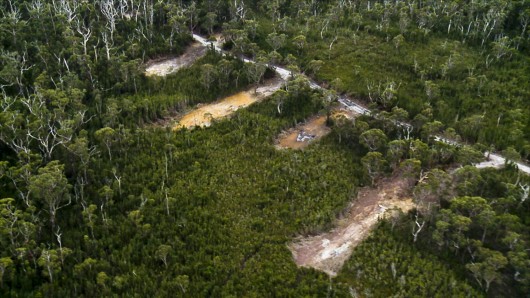 Shree Minerals – foreign miners pillaging Tasmania’s precious Tarkine wilderness
(Photo courtesy of Tarkine National Coalition, click photo to enlarge) Shree Minerals – foreign miners pillaging Tasmania’s precious Tarkine wilderness
(Photo courtesy of Tarkine National Coalition, click photo to enlarge)
.
Tarkine National Coalition has described the Shree Minerals’ Environmental Impact Statement (EIS) for the proposed Nelson Bay River open cut iron ore mine as a mismatch of omissions, flawed assumptions and misrepresentations.
Key data on endangered orchids is missing,
and projections on impacts on Tasmanian Devil and Spotted-tailed Quoll
are based on flawed and fanciful data.
 Spotted-tailed Quoll Spotted-tailed Quoll
.
The EIS produced by the company as part of the Commonwealth environmental assessments has failed to produce a report relating to endangered and critically endangered orchid populations in the vicinity of the proposed open cut mine. The soil borne Mychorizza fungus is highly succeptible to changes in hydrology, and is essential to the germination of the area’s native orchids which cannot exist without Mychorizza. Federal Environment Minister Tony Burke included this report as a requirement in the project’s EIS guidelines issued in June 2011.
 Australia’s Minister for Environment
Tony Burke Australia’s Minister for Environment
Tony Burke
.
“Shree Minerals have decided that undertaking the necessary work on the proposal is likely to uncover some inconvenient truths, and so instead of producing scientific reports they are asking us to suspend common sense and accept that a 220 metre deep hole extending 1km long will have no impact on hydrology.” said Tarkine National Coalition spokesperson Scott Jordan.
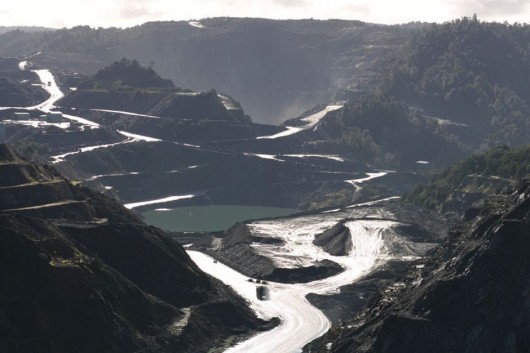 Utter devastation
A magnetite mine at nearby Savage River Utter devastation
A magnetite mine at nearby Savage River
.
“It’s a ridiculous notion when you consider that the mine depth will be some 170 metres below the level of the adjacent Nelson Bay River.”
TNC has also questioned the company’s motives in the clear contradictions and misrepresentations in the data relating to projections of Tasmanian devil roadkill from mine related traffic. The company has used a January-February traffic surveys as a current traffic baseline which skews the data due to the higher level of tourist, campers and shackowner during the traditional summer holiday season.
Department of Infrastructure, Energy and Resources (Tasmania) (DIER) data indicates that there is a doubling of vehicles on these road sections between October and January.
The company also asserted an assumed level of mine related traffic that is substantially lower than their own expert produced Traffic Impact Assessment.
The roadkill assumptions were made on an additional 82 vehicles per day in year one, and 34 vehicles per day in years 2-10, while the figures the Traffic Impact Assessment specify 122 vehicles per day in year one, and 89 vehicles per day in ongoing years.
“When you apply the expert Traffic Impact Assessment data and the DIER’s data for current road use, the increase in traffic is 329% in year one and 240% in years 2-10 which contradicts the company’s flawed projections of 89% and 34%”.
“This increase of traffic will, on the company’s formulae, result in up to 32 devil deaths per year, not the 3 per year in presented in the EIS.”
“Shree Minerals either is too incompetent to understand it’s own expert reports, or they have set out to deliberately mislead the Commonwealth and State environmental assessors.”
“Either way, they are unfit to be trusted with a Pilbara style iron ore mine in stronghold of threatened species like the Tarkine.”
The public comment period closed on Monday, and the company now has to compile public comments received and submit them with the EIS to the Commonwealth.
.
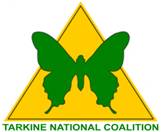 . .
Discovery of Tasmanian devil facial tumour disease in the Tarkine
Media Release 20120224
.
Tarkine National Coalition has described the discovery of Tasmanian Devil Facial Tumour Disease (DFTD) at Mt Lindsay in the Tarkine as a tragedy.
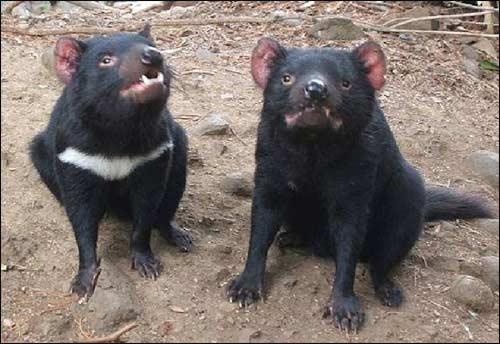
“The Tarkine has been for a number of years the last bastion of disease free devils, and news that the disease has been found in the south eastern zone of the Tarkine is devastating news”, said Tarkine National Coalition spokesperson Scott Jordan.
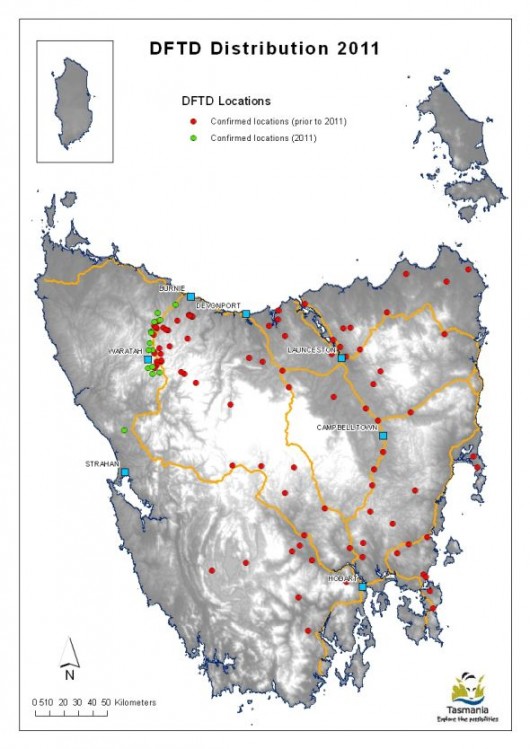
“It is now urgent that the federal and state governments step up and take immediate action to prevent any factors that may exacerbate or accelerate the transmission of this disease to the remaining healthy populations in the Tarkine”.
“The decisions made today will have a critical impact on the survival of the Devil in the wild. Delay is no longer an option – today is the day for action.”
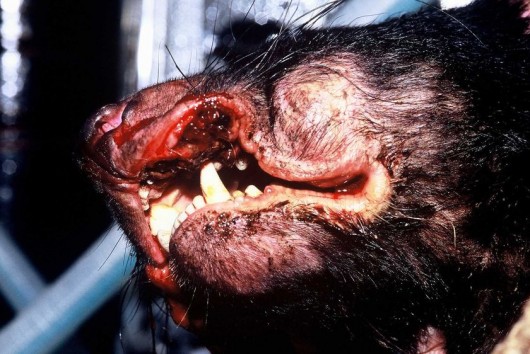
“They should start by reinstating the Emergency National Heritage Listing and placing an immediate halt on all mineral exploration activity in the Tarkine to allow EPBC assessments.”
.
NOTE: EPBC stands for Australia’s Environment Protection and Biodiversity Conservation Act 1999
.
.
 . .
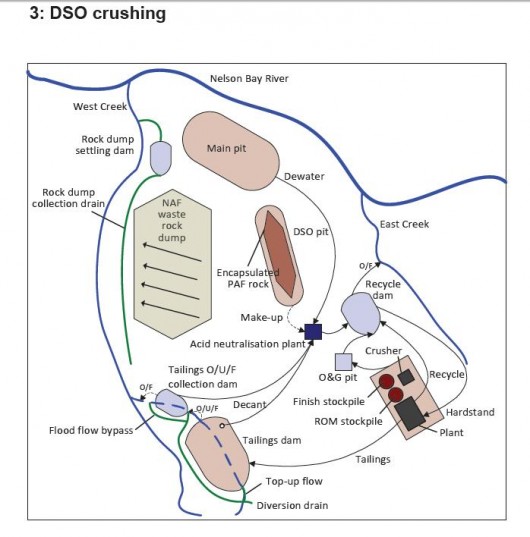 Proposed Mine Site Plan (Direct Shipping Ore) with flows to enter tributaries of Nelson River
(Source: Shree Minerals EIS, 2011) Proposed Mine Site Plan (Direct Shipping Ore) with flows to enter tributaries of Nelson River
(Source: Shree Minerals EIS, 2011)
.
“The Nelson Bay Iron Ore Project (ELs 41/2004 & 54/2008) covers the Nelson Bay Magnetite deposit with Inferred Mineral Resources reported to Australasian Joint Ore Reserves Committee (JORC) guidelines. Drilling will look to enlarge the deposit and improve the quality of the resource, currently standing at 6.8 Million tonnes @ 38.2% magnetite at a 20% magnetite cut off. In addition exploration work will look follow up recent drilling of near surface iron oxide mineralisation in an attempt delineate direct shipping ore. Exploration of additional magnetic targets will also be undertaken.”
[Source: Shree Minerals website, ^http://www.shreeminerals.com/shreemin/scripts/page.asp?mid=16&pageid=27]
.
The Irreversible Ecological Damage of Long Wall Mining
.
‘Impacts of Longwall Coal Mining on The Environment‘ >Read Report (700kb)
[Source: Total Environment Centre, NSW, 2007, ^http://www.tec.org.au/component/docman/doc_view/201-longwall-rep07]
.
Mining Experience in New South Wales – Waratah Rivulet
[Source: ^http://riverssos.org.au/mining-in-nsw/waratah-rivulet/]
.
The image belows show the shocking damage caused by longwall coal mining to the Waratah Rivulet, which flows into Woronora Dam.
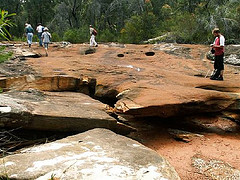
Longwalls have run parallel to and directly under this once pristine waterway in the Woronora Catchment Special Area. You risk an $11,000 fine if you set foot in the Catchment without permission, yet coal companies can cause irreparable damage like this and get away with it.
Waratah Rivulet is a third order stream that is located just to the west of Helensburgh and feeds into the Woronora Dam from the south. Along with its tributaries, it makes up about 29% of the Dam catchment. The Dam provides both the Sutherland Shire and Helensburgh with drinking water. The Rivulet is within the Sydney Catchment Authority managed Woronora Special Area there is no public access without the permission of the SCA. Trespassers are liable to an $11,000 fine.
.
Longwall Mining under Waratah Rivulet
Metropolitan Colliery operates under the Woronora Special Area. Excel Coal operated it until October 2006 when Peabody Energy, the world’s largest coal mining corporation, purchased it. The method of coal extraction is longwall mining. Recent underground operations have taken place and still are taking place directly below the Waratah Rivulet and its catchment area.
In 2005 the NSW Scientific Committee declared longwall mining to be a key threatening process (read report below). The Waratah Rivulet was listed in the declaration along with several other rivers and creeks as being damaged by mining. No threat abatement plan was ever completed.
In September 2006, conservation groups were informed that serious damage to the Waratah Rivulet had taken place. Photographs were provided and an inspection was organised through the Sydney Catchment Authority (SCA) to take place on the 24th of November. On November 23rd, the Total Environment Centre met with Peabody Energy at the mining company’s request. They had heard of our forthcoming inspection and wanted to tell us about their operation and future mining plans. Through a PowerPoint presentation they told us we would be shocked by what we would see and that water had drained from the Rivulet but was reappearing further downstream closer to the dam.
The inspection took place on the 24th of November and was attended by officers from the SCA and the Department of Environment and Conservation (DEC), the Total Environment Centre, Colong Foundation, Rivers SOS and two independent experts on upland swamps and sandstone geology. We walked the length of the Rivulet that flows over the longwall panels. Although, similar waterways in the area are flowing healthily, the riverbed was completely dry for much of its length. It had suffered some of the worst cracking we had ever seen as a result of longwall mining. The SCA officers indicated that at one series of pools, water levels had dropped about 3m. We were also told there is anecdotal evidence suggesting the Rivulet has ceased to pass over places never previously known to have stopped flowing.
It appeared that the whole watercourse had tilted to the east as a result of the subsidence and upsidence. Rock ledges that were once flat now sloped. Iron oxide pollution stains were also present. The SCA also told us that they did not know whether water flows were returning further downstream. There was also evidence of failed attempts at remediation with a distinctly different coloured sand having washed out of cracks and now sitting on the dry river bed or in pools.
Also undermined was Flat Rock Swamp at the southernmost extremity of the longwall panels. It is believed to be the main source of water recharge for the Waratah Rivulet. It is highly likely that the swamp has also been damaged and is sitting on a tilt.
TEC has applied under Freedom of Information legislation to the SCA for documents that refer to the damage to the Waratah Rivulet.
During the meeting with Peabody on 23rd November, the company stated its intentions sometime in 2007 to submit a 3A application under the EP&A Act 1974 (NSW) to mine a further 27 longwall panels that will run under the Rivulet and finish under the Woronora Dam storage area.
This is very alarming given the damage that has already occurred to a catchment that provides the Sutherland Shire & Helensburgh with 29% of their drinking water. The dry bed of Waratah Rivulet above the mining area and the stain of iron oxide pollution may be seen clearly through Google Earth.
.
The Bigger Picture
In 2005 Rivers SOS, a coalition of 30 groups, formed with the aim of campaigning for the NSW Government to mandate a safety zone of at least 1km around rivers and creeks threatened by mining in NSW.
The peak environment groups of NSW endorse this position and it forms part of their election policy document.
.
Longwall Mining under or close to Rivers and Streams:
.
Seven major rivers and numerous creeks in NSW have been permanently damaged by mining operations which have been allowed to go too close to, or under, riverbeds. Some rivers are used as channels for saline and acid wastewater pumped out from mines. Many more are under threat. The Minister for Primary Industries, Ian Macdonald, is continuing to approve operations with the Department of Planning and DEC also involved in the process, as are a range of agencies (EPA, Fisheries, DIPNR, SCA, etc.) on an Interagency Review Committee. This group gives recommendations concerning underground mine plans to Ian Macdonald, but has no further say in his final decision. A document recently obtained under FOI by Rivers SOS shows that an independent consultant to the Interagency Committee recommended that mining come no closer than 350m to the Cataract River, yet the Minister approved mining to come within 60m.
The damage involves multiple cracking of river bedrock, ranging from hairline cracks to cracks up to several centimetres wide, causing water loss and pollution as ecotoxic chemicals are leached from the fractured rocks.
.
Aquifers may often be breached.
.
Satisfactory remediation is not possible. In addition, rockfalls along mined river gorges are frequent. The high price of coal and the royalties gained from expanding mines are making it all too tempting for the Government to compromise the integrity of our water catchments and sacrifice natural heritage.
.
Longwall Mining in the Catchments
.
Longwall coal mining is taking place across the catchment areas south of Sydney and is also proposed in the Wyong catchment. Of particular concern is BHP-B’s huge Dendrobium mine which is undermining the Avon and Cordeaux catchments, part of Sydney’s water supply.
A story in the Sydney Morning Herald in January 2005 stated that the SCA were developing a policy for longwall coal mining within the catchments that would be ready by the middle of that year. This policy is yet to materialise.
The SMP approvals process invariably promises remediation and further monitoring. But damage to rivers continues and applications to mine areapproved with little or no significant conditions placed upon the licence.
Remediation involves grouting some cracks but cannot cover all of the cracks, many of which go undetected, in areas where the riverbed is sandy for example.
Sometimes the grout simply washes out of the crack, as is the case in the Waratah Rivulet.
The SCA was established as a result of the 1998 Sydney water crisis. Justice Peter McClellan, who led the subsequent inquiry, determined that a separate catchment management authority with teeth should be created because, as he said “someone should wake up in the morning owning the issue” of adequate management.
An audit of the SCA and the catchments in 1999 found multiple problems including understaffing, the need to interact with so many State agencies, and enormous pressure from developers. Developers in the catchments include mining companies. In spite of government policies such as SEPP 58, stating that development in catchments should have only a “neutral or beneficial effect” on water quality, longwall coal mining in the catchments have been, and are being, approved by the NSW government.
Overidden by the Mining Act 1992, the SCA appears powerless to halt the damage to Sydney’s water supply.
.
Alteration of habitat following subsidence due to longwall mining – key threatening process listing
[Source: ‘Alteration of habitat following subsidence due to longwall mining – key threatening process listing’, Dr Lesley Hughes, ChairpersonScientific Committee, Proposed Gazettal date: 15/07/05, Exhibition period: 15/07/05 – 09/09/05on Department of Environment (NSW) website,^http://www.environment.nsw.gov.au/determinations/LongwallMiningKtp.htm]
.
NSW Scientific Committee – final determination
.
The Scientific Committee, established by the Threatened Species Conservation Act, has made a Final Determination to list Alteration of habitat following subsidence due to longwall mining as a KEY THREATENING PROCESS in Schedule 3 of the Act. Listing of key threatening processes is provided for by Part 2 of the Act.
.
The Scientific Committee has found that:
1. Longwall mining occurs in the Northern, Southern and Western Coalfields of NSW. The Northern Coalfields are centred on the Newcastle-Hunter region. The Southern Coalfield lies principally beneath the Woronora, Nepean and Georges River catchments approximately 80-120 km SSW of Sydney. Coalmines in the Western Coalfield occur along the western margin of the Sydney Basin. Virtually all coal mining in the Southern and Western Coalfields is underground mining.
2. Longwall mining involves removing a panel of coal by working a face of up to 300 m in width and up to two km long. Longwall panels are laid side by side with coal pillars, referred to as “chain pillars” separating the adjacent panels. Chain pillars generally vary in width from 20-50 m wide (Holla and Barclay 2000). The roof of the working face is temporarily held up by supports that are repositioned as the mine face advances (Karaman et al. 2001). The roof immediately above the coal seam then collapses into the void (also known as the goaf) and a collapse zone is formed above the extracted area. This zone is highly fractured and permeable and normally extends above the seam to a height of five times the extracted seam thickness (typical extracted seam thickness is approximately 2-3.5 m) (ACARP 2002). Above the collapse zone is a fractured zone where the permeability is increased to a lesser extent than in the collapse zone. The fractured zone extends to a height above the seam of approximately 20 times the seam thickness, though in weaker strata this can be as high as 30 times the seam thickness (ACARP 2002). Above this level, the surface strata will crack as a result of bending strains, with the cracks varying in size according to the level of strain, thickness of the overlying rock stratum and frequency of natural joints or planes of weakness in the strata (Holla and Barclay 2000).
3. The principal surface impact of underground coal mining is subsidence (lowering of the surface above areas that are mined) (Booth et al. 1998, Holla and Barclay 2000). The total subsidence of a surface point consists of two components, active and residual. Active subsidence, which forms 90 to 95% of the total subsidence in most cases, follows the advance of the working face and usually occurs immediately. Residual subsidence is time-dependent and is due to readjustment and compaction within the goaf (Holla and Barclay 2000). Trough-shaped subsidence profiles associated with longwall mining develop tilt between adjacent points that have subsided different amounts.
Maximum ground tilts are developed above the edges of the area of extraction and may be cumulative if more than one seam is worked up to a common boundary. The surface area affected by ground movement is greater than the area worked in the seam (Bell et al. 2000). In the NSW Southern Coalfield, horizontal displacements can extend for more than one kilometre from mine workings (and in extreme cases in excess of three km) (ACARP 2002, 2003), although at these distances, the horizontal movements have little associated tilt or strain. Subsidence at a surface point is due not only to mining in the panel directly below the point, but also to mining in the adjacent panels. It is not uncommon for mining in each panel to take a year or so and therefore a point on the surface may continue to experience residual subsidence for several years (Holla and Barclay 2000).
4. The degree of subsidence resulting from a particular mining activity depends on a number of site specific factors. Factors that affect subsidence include the design of the mine, the thickness of the coal seam being extracted, the width of the chain pillars, the ratio of the depth of overburden to the longwall panel width and the nature of the overlying strata; sandstones are known to subside less than other substrates such as shales. Subsidence is also dependent on topography, being more evident in hilly terrain than in flat or gently undulating areas (Elsworth and Liu 1995, Holla 1997, Holla and Barclay 2000, ACARP 2001). The extent and width of surface cracking over and within the vicinity of the mined goaf will also decrease with an increased depth of mining (Elsworth and Liu 1995).
5. Longwall mining can accelerate the natural process of ‘valley bulging’ (ACARP 2001, 2002). This phenomenon is indicated by an irregular upward spike in an otherwise smooth subsidence profile, generally co-inciding with the base of the valley. The spike represents a reduced amount of subsidence, known as ‘upsidence’, in the base and sides of the valley and is generally coupled with the horizontal closure of the valley sides (ACARP 2001, 2002). In most cases, the upsidence effects extend outside the valley and include the immediate cliff lines and ground beyond them (ACARP 2002).
6. Mining subsidence is frequently associated with cracking of valley floors and creeklines and with subsequent effects on surface and groundwater hydrology (Booth et al. 1998, Holla and Barclay 2000, ACARP 2001, 2002, 2003). Subsidence-induced cracks occurring beneath a stream or other surface water body may result in the loss of water to near-surface groundwater flows.
If the water body is located in an area where the coal seam is less than approximately 100-120 m below the surface, longwall mining can cause the water body to lose flow permanently. If the coal seam is deeper than approximately 150 m, the water loss may be temporary unless the area is affected by severe geological disturbances such as strong faulting. In the majority of cases, surface waters lost to the sub-surface re-emerge downstream. The ability of the water body to recover is dependent on the width of the crack, the surface gradient, the substrate composition and the presence of organic matter. An already-reduced flow rate due to drought conditions or an upstream dam or weir will increase the impact of water loss through cracking. The potential for closure of surface cracks is improved at sites with a low surface gradient although even temporary cracking, leading to loss of flow, may have long-term effects on ecological function in localised areas. The steeper the gradient, the more likely that any solids transported by water flow will be moved downstream allowing the void to remain open and the potential loss of flows to the subsurface to continue.
A lack of thick alluvium in the streambed may also prolong stream dewatering (by at least 13 years, in one case study in West Virginia, Gill 2000).
Impacts on the flows of ephemeral creeks are likely to be greater than those on permanent creeks (Holla and Barclay 2000). Cracking and subsequent water loss can result in permanent changes to riparian community structure and composition.
7. Subsidence can also cause decreased stability of slopes and escarpments, contamination of groundwater by acid drainage, increased sedimentation, bank instability and loss, creation or alteration of riffle and pool sequences, changes to flood behaviour, increased rates of erosion with associated turbidity impacts, and deterioration of water quality due to a reduction in dissolved oxygen and to increased salinity, iron oxides, manganese, and electrical conductivity (Booth et al. 1998, Booth and Bertsch 1999, Sidle et al. 2000, DLWC 2001, Gill 2000, Stout 2003). Displacement of flows may occur where water from mine workings is discharged at a point or seepage zone remote from the stream, and in some cases, into a completely different catchment. Where subsidence cracks allow surface water to mix with subsurface water, the resulting mixture may have altered chemical properties. The occurrence of iron precipitate and iron-oxidising bacteria is particularly evident in rivers where surface cracking has occurred. These bacteria commonly occur in Hawkesbury Sandstone areas, where seepage through the rock is often rich in iron compounds (Jones and Clark 1991) and are able to grow in water lacking dissolved oxygen. Where the bacteria grow as thick mats they reduce interstitial habitat, clog streams and reduce available food (DIPNR 2003). Loss of native plants and animals may occur directly via iron toxicity, or indirectly via smothering. Long-term studies in the United States indicate that reductions in diversity and abundance of aquatic invertebrates occur in streams in the vicinity of longwall mining and these effects may still be evident 12 years after mining (Stout 2003, 2004).
8. The extraction of coal and the subsequent cracking of strata surrounding the goaf may liberate methane, carbon dioxide and other gases. Most of the gas is removed by the ventilation system of the mine but some gas remains within the goaf areas. Gases tend to diffuse upwards through any cracks occurring in the strata and be emitted from the surface (ACARP 2001). Gas emissions can result in localised plant death as anaerobic conditions are created within the soil (Everett et al. 1998).
9. Subsidence due to longwall mining can destabilise cliff-lines and increase the probability of localised rockfalls and cliff collapse (Holla and Barclay 2000, ACARP 2001, 2002). This has occurred in the Western Coalfield and in some areas of the Southern Coalfield (ACARP 2001). These rockfalls have generally occurred within months of the cliffline being undermined but in some cases up to 18 years after surface cracking first became visible following mining (ACARP 2001). Changes to cliff-line topography may result in an alteration to the environment of overhangs and blowouts. These changes may result in the loss of roosts for bats and nest sites for cliff-nesting birds.
10. Damage to some creek systems in the Hunter Valley has been associated with subsidence due to longwall mining. Affected creeks include Eui Creek, Wambo Creek, Bowmans Creek, Fishery Creek and Black Creek (Dept of Sustainable Natural Resources 2003, in lit.). Damage has occurred as a result of loss of stability, with consequent release of sediment into the downstream environment, loss of stream flow, death of fringing vegetation, and release of iron rich and occasionally highly acidic leachate. In the Southern Coalfields substantial surface cracking has occurred in watercourses within the Upper Nepean, Avon, Cordeaux, Cataract, Bargo, Georges and Woronora catchments, including Flying Fox Creek, Wongawilli Creek, Native Dog Creek and Waratah Rivulet. The usual sequence of events has been subsidence-induced cracking within the streambed, followed by significant dewatering of permanent pools and in some cases complete absence of surface flow.
11. The most widely publicised subsidence event in the Southern Coalfields was the cracking of the Cataract riverbed downstream of the Broughtons Pass Weir to the confluence of the Nepean River. Mining in the vicinity began in 1988 with five longwall panels having faces of 110 m that were widened in 1992 to 155 m. In 1994, the river downstream of the longwall mining operations dried up (ACARP 2001, 2002). Water that re-emerged downstream was notably deoxygenated and heavily contaminated with iron deposits; no aquatic life was found in these areas (Everett et al. 1998). In 1998, a Mining Wardens Court Hearing concluded that 80% of the drying of the Cataract River was due to longwall mining operations, with the balance attributed to reduced flows regulated by Sydney Water. Reduction of the surface river flow was accompanied by release of gas, fish kills, iron bacteria mats, and deterioration of water quality and instream habitat. Periodic drying of the river has continued, with cessation of flow recorded on over 20 occasions between June 1999 and October 2002 (DIPNR 2003). At one site, the ‘Bubble Pool”, localised water loss up to 4 ML/day has been recorded (DIPNR 2003).
Piezometers indicated that there was an unusually high permeability in the sandstone, indicating widespread bedrock fracturing (DIPNR 2003). High gas emissions within and around areas of dead vegetation on the banks of the river have been observed and it is likely that this dieback is related to the generation of anoxic conditions in the soil as the migrating gas is oxidised (Everett et al. 1998). An attempt to rectify the cracking by grouting of the most severe crack in 1999 was only partially successful (AWT 2000). In 2001, water in the Cataract River was still highly coloured, flammable gas was still being released and flow losses of about 50% (3-3.5 ML/day) still occurring (DLWC 2001). Environmental flow releases of 1.75 ML/day in the Cataract River released from Broughtons Pass Weir were not considered enough to keep the river flowing or to maintain acceptable water quality (DIPNR 2003).
12. Subsidence associated with longwall mining has contributed to adverse effects (see below) on upland swamps. These effects have been examined in most detail on the Woronora Plateau (e.g. Young 1982, Gibbins 2003, Sydney Catchment Authority, in lit.), although functionally similar swamps exist in the Blue Mountains and on Newnes Plateau and are likely to be affected by the same processes. These swamps occur in the headwaters of the Woronora River and O’Hares Creek, both major tributaries of the Georges River, as well as major tributaries of the Nepean River, including the Cataract and Cordeaux Rivers. The swamps are exceptionally species rich with up to 70 plant species in 15 m2 (Keith and Myerscough 1993) and are habitats of particular conservation significance for their biota. The swamps occur on sandstone in valleys with slopes usually less than ten degrees in areas of shallow, impervious substrate formed by either the bedrock or clay horizons (Young and Young 1988). The low gradient, low discharge streams cannot effectively flush sediment so they lack continuous open channels and water is held in a perched water table. The swamps act as water filters, releasing water slowly to downstream creek systems thus acting to regulate water quality and flows from the upper catchment areas (Young and Young 1988).
13. Upland swamps on the Woronora Plateau are characterised by ti-tree thicket, cyperoid heath, sedgeland, restioid heath and Banksia thicket with the primary floristic variation being related to soil moisture and fertility (Young 1986, Keith and Myerscough 1993). Related swamp systems occur in the upper Blue Mountains including the Blue Mountains Sedge Swamps (also known as hanging swamps) which occur on steep valley sides below an outcropping claystone substratum and the Newnes Plateau Shrub Swamps and Coxs River Swamps which are also hydrologically dependent on the continuance of specific topographic and geological conditions (Keith and Benson 1988, Benson and Keith 1990). The swamps are subject to recurring drying and wetting, fires, erosion and partial flushing of the sediments (Young 1982, Keith 1991). The conversion of perched water table flows into subsurface flows through voids, as a result of mining-induced subsidence may significantly affect the water balance of upland swamps (eg Young and Wray 2000). The scale of this impact is currently unknown, however, changes in vegetation may not occur immediately. Over time, areas of altered hydrological regime may experience a modification to the vegetation community present, with species being favoured that prefer the new conditions. The timeframe of these changes is likely to be long-term. While subsidence may be detected and monitored within months of a mining operation, displacement of susceptible species by those suited to altered conditions is likely to extend over years to decades as the vegetation equilibrates to the new hydrological regime (Keith 1991, NPWS 2001). These impacts will be exacerbated in periods of low flow. Mine subsidence may be followed by severe and rapid erosion where warping of the swamp surface results in altered flows and surface cracking creates nick-points (Young 1982). Fire regimes may also be altered, as dried peaty soils become oxidised and potentially flammable (Sydney Catchment Authority, in lit.) (Kodela et al. 2001).
14. The upland swamps of the Woronora Plateau and the hanging swamps of the Blue Mountains provide habitat for a range of fauna including birds, reptiles and frogs. Reliance of fauna on the swamps increases during low rainfall periods. A range of threatened fauna including the Blue Mountains Water Skink, Eulamprus leuraensis, the Giant Dragonfly, Petalura gigantea, the Giant Burrowing Frog, Heleioporus australiacus, the Red-crowned Toadlet, Pseudophryne australis, the Stuttering Frog Mixophyes balbus and Littlejohn’s Tree Frog, Litoria littlejohni, are known to use the swamps as habitat. Of these species, the frogs are likely to suffer the greatest impacts as a result of hydrological change in the swamps because of their reliance on the water within these areas either as foraging or breeding habitat. Plant species such as Persoonia acerosa, Pultenaea glabra, P. aristata and Acacia baueri ssp. aspera are often recorded in close proximity to the swamps.
Cliffline species such as Epacris hamiltonii and Apatophyllum constablei that rely on surface or subsurface water may also be affected by hydrological impacts on upland swamps, as well as accelerated cliff collapse associated with longwall mining.
15. Flora and fauna may also be affected by activities associated with longwall mining in addition to the direct impacts of subsidence. These activities include clearing of native vegetation and removal of bush rock for surface facilities such as roads and coal wash emplacement and discharge of mine water into swamps and streams. Weed invasion, erosion and siltation may occur following vegetation clearing or enrichment by mine water. Clearing of native vegetation, Bushrock removal, Invasion of native plant communities by exotic perennial grasses and Alteration to the natural flow regimes of rivers and streams and their floodplains and wetlands are listed as Key Threatening Processes under the Threatened Species Conservation Act (1995).
.
The following threatened species and ecological communities are known to occur in areas affected by subsidence due to longwall mining and their habitats are likely to be altered by subsidence and mining-associated activities:
Endangered Species
- Epacris hamiltonii a shrub
- Eulamprus leuraensis Blue Mountains Water Skink
- Hoplocephalus bungaroides Broad-headed Snake
- Isoodon obesulus Southern Brown Bandicoot
- Petalura gigantea Giant Dragonfly
.
Vulnerable species
- Acacia baueri subsp. aspera
- Apatophyllum constablei
- Boronia deanei
- Cercartetus nanus Eastern Pygmy Possum
- Epacris purpurascens var. purpurascens
- Grevillea longifolia
- Heleioporus australiacus Giant Burrowing Frog
- Ixobrychus flavicollis Black Bittern
- Leucopogon exolasius
- Litoria littlejohni Littlejohn’s Tree Frog
- Melaleuca deanei
- Mixophyes balbus Stuttering Frog
- Myotis adversus Large-footed Myotis
- Persoonia acerosa
- Potorous tridactylus Long-nosed Potoroo
- Pseudophryne australis Red-crowned Toadlet
- Pteropus poliocephalus Grey-headed Flying Fox
- Pterostylis pulchella
- Pultenaea aristata
- Pultenaea glabra
- Tetratheca juncea
- Varanus rosenbergi Rosenberg’s Goanna
.
Endangered Ecological Communities
.
- Genowlan Point Allocasuarina nana Heathland
- Newnes Plateau Shrub Swamp in the Sydney Basin Bioregion
- O’Hares Creek Shale Forest
- Shale/Sandstone Transition Forest
.
Species and populations of species not currently listed as threatened but that may become so as a result of habitat alteration following subsidence due to longwall mining include:
- Acacia ptychoclada
- Almaleea incurvata
- Darwinia grandiflora
- Dillwynia stipulifera
- Epacris coricea
- Grevillea acanthifolia subsp. acanthifolia
- Hydromys chrysogaster Water rat
- Lomandra fluviatilis
- Olearia quercifolia
- Pseudanthus pimelioides
.
16. Mitigation measures to repair cracking creek beds have had only limited success and are still considered experimental (ACARP 2002). Cracks less than 10 mm wide may eventually reseal without active intervention provided there is a clay fraction in the soil and at least some water flow is maintained.
Cracks 10-50 mm wide may be sealed with a grouting compound or bentonite.
Cracks wider than 50 mm require concrete (ACARP 2002). Pattern grouting in the vicinity of Marhnyes Hole in the Georges River has been successful at restoring surface flows and reducing pool drainage following fracturing of the riverbed (International Environmental Consultants 2004). Grouting of cracks also appears to have been relatively effective in Wambo Creek in the Hunter Valley. Installation of a grout curtain in the Cataract River, however, has been only partially successful and it was concluded in 2002, after rehabilitation measures had taken place, that the environment flows released from Broughtons Pass Weir by the Sydney Catchment Authority were insufficient to keep the Cataract River flowing or to maintain acceptable water quality (DIPNR 2003). Mitigation measures themselves may have additional environmental impacts due to disturbance from access tracks, the siting of drilling rigs, removal of riparian vegetation, and unintended release of the grouting material into the water. Furthermore, even measures that are successful in terms of restoring flows involve temporary rerouting of surface flows while mitigation is carried out (generally for 2-3 weeks at each grouting site). Planning for remediation measures may also be hampered by the lack of predictability of some impacts, and difficulties gaining access to remote areas where remedial works are needed. The long-term success of mitigation measures such as grouting is not yet known. It is possible that any ongoing subsidence after grouting may reopen cracks or create new ones.
Further, it is not yet known whether the clay substance bentonite, which is often added to the cement in the grouting mix, is sufficiently stable to prevent shrinkage. Grouting under upland and hanging swamps that have no definite channel is probably not feasible.
17. Empirical methods have been developed from large data sets to predict conventional subsidence effects (ACARP 2001, 2002, 2003). In general, these models have proved more accurate when predicting the potential degree of subsidence in flat or gently undulating terrain than in steep topography (ACARP 2003). A major issue identified in the ACARP (2001, 2002) reports was the lack of knowledge about horizontal stresses in geological strata, particularly those associated with river valleys. These horizontal stresses appear to play a major role in the magnitude and extent of surface subsidence impacts. The cumulative impacts of multiple panels also appear to have been poorly monitored. The general trend in the mining industry in recent years toward increased panel widths (from 200 up to 300 m), which allows greater economies in the overall costs of extraction, means that future impacts will tend to be greater than those in the past (ACARP 2001, 2002).
18. In view of the above the Scientific Committee is of the opinion that Alteration of habitat following subsidence due to longwall mining adversely affects two or more threatened species, populations or ecological communities, or could cause species, populations or ecological communities that are not threatened to become threatened.
.
References
.
ACARP (2001) ‘Impacts of Mine Subsidence on the Strata & Hydrology of River Valleys – Management Guidelines for Undermining Cliffs, Gorges and River Systems’. Australian Coal Association Research Program Final Report C8005 Stage 1, March 2001.
ACARP (2002) ‘Impacts of Mine Subsidence on the Strata & Hydrology of River Valleys – Management Guidelines for Undermining Cliffs, Gorges and River Systems’. Australian Coal Association Research Program Final Report C9067 Stage 2, June 2002.
ACARP (2003) ‘Review of Industry Subsidence Data in Relation to the Influence of Overburden Lithology on Subsidence and an Initial Assessment of a Sub-Surface Fracturing Model for Groundwater Analysis’. Australian Coal Association Research Program Final Report C10023, September 2003.
AWT (2000) ‘Investigation of the impact of bed cracking on water quality in the Cataract River.’ Prepared for the Dept. of Land and Water Conservation Sydney South Coast Region. AWT Report no. 2000/0366.
Bell FG, Stacey TR, Genske DD (2000) Mining subsidence and its effect on the environment: some differing examples. Environmental Geology 40, 135-152.
Benson DH, Keith DA (1990) The natural vegetation of the Wallerawang 1:100,000 map sheet. Cunninghamia 2, 305-335.
Booth CJ, Bertsch LP (1999) Groundwater geochemistry in shallow aquifers above longwall mines in Illinois, USA. Hydrogeology Journal 7, 561-575.
Booth CJ, Spande ED, Pattee CT, Miller JD, Bertsch LP (1998) Positive and negative impacts of longwall mine subsidence on a sandstone aquifer.
Environmental Geology 34, 223-233.
DIPNR (2003) ‘Hydrological and water quality assessment of the Cataract River; June 1999 to October 2002: Implications for the management of longwall coal mining.’ NSW Department of Infrastructure, Planning and Environment, Wollongong.
DLWC (2001) ‘Submission to the Commission of Inquiry into the Proposed Dendrobium Underground Coal Mine Project by BHP Steel (AIS) Pty Ltd, Wollongong, Wingecarribee & Wollondilly Local Government Areas’. Department of Land and Water Conservation, July 2001.
Elsworth D, Liu J (1995) Topographic influence of longwall mining on ground-water supplies. Ground Water 33, 786-793.
Everett M, Ross T, Hunt G (eds) (1998) ‘Final Report of the Cataract River Taskforce. A report to the Upper Nepean Catchment Management Committee of the studies of water loss in the lower Cataract River during the period 1993 to 1997.’ Cataract River Taskforce, Picton.
Gibbins L (2003) A geophysical investigation of two upland swamps, Woronora Plateau, NSW, Australia. Honours Thesis, Macquarie University.
Gill DR (2000) Hydrogeologic analysis of streamflow in relation to undergraound mining in northern West Virginia. MSc thesis, West Virginia University, Morgantown, West Virginia.
Holla L (1997) Ground movement due to longwall mining in high relief areas in New South Wales, Australia. International Journal of Rock Mechanics and Mining Sciences 34, 775-787.
Holla L, Barclay E (2000) ‘Mine subsidence in the Southern Coalfield, NSW, Australia’. Mineral Resources of NSW, Sydney.
International Environmental Consultants Pty Ltd (2004) ‘Pattern grouting remediation activities: Review of Environmental Effects Georges River Pools 5-22. May, 2004’.
Jones DC, Clark NR (eds) (1991) Geology of the Penrith 1:100,000 Sheet 9030, NSW. Geological Survey, NSW Department of Minerals and Energy.
Karaman A, Carpenter PJ, Booth CJ (2001) Type-curve analysis of water-level changes induced by a longwall mine. Environmental Geology 40, 897-901.
Keith DA (1991) Coexistence and species diversity in upland swamp vegetation. PhD thesis. University of Sydney.
Keith DA (1994) Floristics, structure and diversity of natural vegetation in the O’Hares Creek catchment, south of Sydney. Cunninghamia 3, 543-594.
Keith DA, Benson DH (1988) The natural vegetation of the Katoomba 1:100,000 map sheet. Cunninghamia 2, 107-143.
Kodela PG, Sainty GR, Bravo FJ, James TA (2001) ‘Wingecarribee Swamp flora survey and related management issues.’ Sydney Catchment Authority, New South Wales.
Keith DA, Myerscough PJ (1983) Floristics and soil relations of upland swamp vegetation near Sydney. Australian Journal of Ecology 18, 325-344.
NPWS (2001) ‘NPWS Primary Submission to the Commission of Inquiry into the Dendrobium Coal Project’. National Parks and Wildlife Service, July 2001.
Sidle RC, Kamil I, Sharma A, Yamashita S (2000) Stream response to subsidence from underground coal mining in central Utah. Environmental Geology 39, 279-291.
Stout BM III (2003) ‘Impact of longwall mining on headwater streams in northern West Virginia’. Final Report, June 2003 for the West Virginia Water Research Institute.
Stout BM III (2004) ‘Do headwater streams recover from longwall mining impacts in northern West Virginia’. Final Report, August 2004 for the West Virginia Water Research Institute.
Young ARM (1982) Upland swamps (dells) on the Woronora Plateau, N.S.W. PhD thesis, University of Wollongong.
Young ARM (1986) The geomorphic development of upland dells (upland swamps) on the Woronora Plateau, NSW, Australia. Zeitschrift für Geomorphologie N.F. Bd 30, Heft 3,312-327.
Young RW, Wray RAL (2000) The geomorphology of sandstones in the Sydney Region. In McNally GH and Franklin BJ eds Sandstone City – Sydney’s Dimension Stone and other Sandstone Geomaterials. Proceedings of a symposium held on 7th July 2000, 15th Australian Geological Convention, University of
Technology Sydney. Monograph No. 5, Geological Society of Australia, Springwood, NSW. Pp 55-73.
Young RW, Young ARM (1988) ‘Altogether barren, peculiarly romantic’: the sandstone lands around Sydney. Australian Geographer 19, 9-25.
.
Tags: Emergency National Heritage Listing, Nelson Bay Iron Ore Project, Nelson Bay Magnetite, Nelson Bay River, Shree Minerals, spotted-tailed quoll, tarkine, Tasmanian Devil, Tasmanian Devil Facial Tumour Disease, Tony Burke
Posted in Tasmania (AU), Tasmanian Devils, Threats from Mining, Threats to Wild Tasmania | No Comments »
Add this post to Del.icio.us - Digg
Thursday, February 23rd, 2012
The following article is a press release by UK-based NGO, The Environmental Investigation Agency (EIA), of 20120124 entitled ‘Conservation on the Front Line – Muara Tae’s Last Stand Against Big Palm Oil’
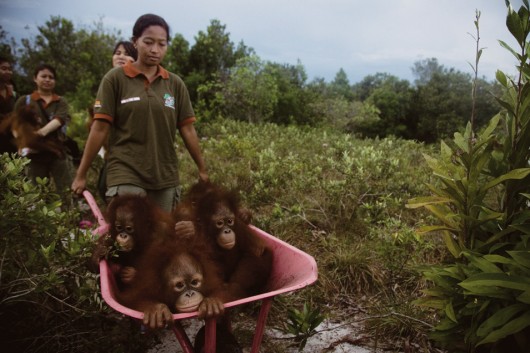 Their ancient rainforest home clearfelled for bloody Palm Oil,
now these Orang-utans are homeless in their own homeland
[Source: ^http://www.pdnphotooftheday.com/2010/05/4673]
(Click photo to enlarge) Their ancient rainforest home clearfelled for bloody Palm Oil,
now these Orang-utans are homeless in their own homeland
[Source: ^http://www.pdnphotooftheday.com/2010/05/4673]
(Click photo to enlarge)
.
MUARA TAE, EAST KALIMANTAN (Borneo, Indonesia):
The fate of a Dayak indigenous community, deep in the interior of East Kalimantan (Borneo) demonstrates how Indonesia must safeguard the rights of indigenous people if it is to meet ambitious targets to reduce emissions from deforestation.
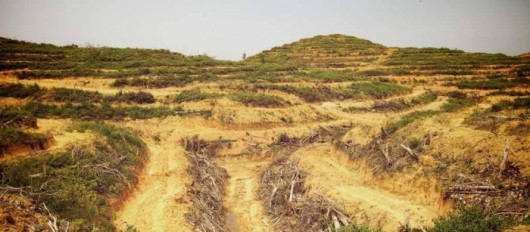 Cleared land at Muara Tae
(c) EIA/Telapak Cleared land at Muara Tae
(c) EIA/Telapak
.
The Dayak Benuaq of Muara Tae, in West Kutai Kabupaten (Indonesia), today face a two-pronged assault from palm oil companies aggressively expanding into their ancestral forests. Together with Indonesian NGO Telapak, the community is manning a forest outpost around the clock in a last ditch attempt to save it from destruction.
The London-based Environmental Investigation Agency (EIA) has witnessed at first-hand the Dayak Benuaq’s struggle, and how their sustainable use of forests could help Indonesia deliver on its ambitious targets to reduce greenhouse gas emissions.
EIA Forests Team Leader Faith Doherty said: “There are more than 800 families in Muara Tae relying on the forests for their food, water, medicine, culture and identity. Put simply, they have to keep this forest in order to survive.
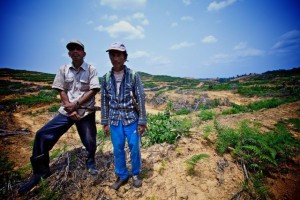 Villagers on cleared land at Muara Tae
(c) EIA/Telapak Villagers on cleared land at Muara Tae
(c) EIA/Telapak
.
“The rhetoric from the President of Indonesia on curbing emissions by reducing deforestation is strong but on the front line, where indigenous communities are putting their lives at risk to protect forests, action is sorely missing.
“Giving these communities, such as the Dayak Benuaq, the rights they deserve is a vital step to reduce catastrophic levels of deforestation in Indonesia.”
President Yudhoyono has pledged to reduce carbon emissions across the archipelago by 26 per cent by 2020 against a business-as-usual baseline, alongside delivering substantial economic growth.
 Self-serving bullshit artist
– take your pick Self-serving bullshit artist
– take your pick
.
Plantation expansion will inevitably be a significant element of growth, but it has historically been a major driver of emissions and it is widely acknowledged that in order avoid them, expansion must now be directed to ‘degraded’ lands.
As a result of weak spatial planning, however, the forests of Muara Tae are identified as ‘APL’, a designation meaning they are not part of the national forest area and are open to exploitation. The theft of indigenous forests also raises serious questions as to what form of ‘development’ these plantations offer.
In indigenous communities such as the Dayak Benuaq of Muara Tae, Indonesia has perhaps its most valuable forest resource. It is due to their sustainable methods, honed over generations, that the forest even remains.
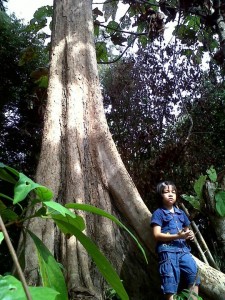 Benuaq girl and ncap payang tree
(c) EIA/Telapak Benuaq girl and ncap payang tree
(c) EIA/Telapak
.
Telapak president Ambrosius Ruwindrijarto said:
“Together with the community, we have not only been protecting the last forests but also planting new Ulin and Meranti saplings to enhance it. These people are the true guardians of the forest and their fate is entwined with it.”
Muara Tae has lost more than half of its land and forests during the past 20 years to mining companies. The impact has been tangible; the villagers’ water source has dried up and they must now routinely make a 1km journey to collect clean water.
The remaining forest is home to a large number of bird species including hornbills, the emblem of Borneo. There are about 20 species of reptiles and it is also a habitat for both proboscis monkeys and honey bears.
 Indonesia’s Environment Minister Gusti Hatta,
all talk..so…’what does an Orang-Utan look like?‘
. Indonesia’s Environment Minister Gusti Hatta,
all talk..so…’what does an Orang-Utan look like?‘
.
The latest land-grabs have taken place since January 2010, when the local Bupati (regional government official), Ismail Thomas, issued plantation permits to two palm oil companies: Malaysian-owned PT Munte Waniq Jaya Perkasa (PT MWJP) and PT Borneo Surya Mining Jaya, a subsidiary of Sumatran logging, mining and plantation conglomerate Surya Dumai.
While the Norwegian Government has been instrumental in financially backing efforts to reduce deforestation in Indonesia through the REDD+ initiative, it has also invested in the parent company of PT MWJP through its sovereign wealth fund.
Pak Singko, a leader of the Dayak Benuaq of Muara Tae, said: “We are calling for help from people everywhere in protecting our forests and ancestral land. We are being squeezed from all sides by mining and plantation companies.
.
“This is the last remaining forests that we have and the only land we have to survive.
If my forests are gone, our lives will end.”
 Cargill’s ecological facism for its self-serving Palm Oil
The destruction of primary rainforest by Duta Palma. West Kalimantan, Borneo.
Cargill was a key purchaser of palm oil from this notorious rainforest destroyer up until 2008. Cargill’s ecological facism for its self-serving Palm Oil
The destruction of primary rainforest by Duta Palma. West Kalimantan, Borneo.
Cargill was a key purchaser of palm oil from this notorious rainforest destroyer up until 2008.
[Source: Photo: David Gilbert/RAN, ^http://www.flickr.com/photos/rainforestactionnetwork/5551935164/]
(Click photo to enlarge)
.
The above photo is from an investigative report from Rainforest Action Network that presents evidence that (US conglomerate) Cargill is operating two undisclosed palm oil plantations in West Kalimantan, Indonesia.
 Cargill’s pathetic claim of its Corporate Responsibility in Indonesia Cargill’s pathetic claim of its Corporate Responsibility in Indonesia
[Source: Cargill corporate website: ^http://www.cargill.com.au/en/index.jsp].
.
When William Wallace Cargill founded our company in 1865, he deliberately set out to ensure that we earned and maintained a reputation for integrity, which he saw as a key differentiator in those times.
Corporate responsibility is part of everything we do. It is a company-wide commitment to apply our global knowledge and experience to help meet complex economic, environmental and social challenges wherever we do business. It is a process of continually improving our standards, our actions and our processes. Corporate responsibility extends not only to our own operations but to our wider communities and is based on four commitments:
- We will conduct our business with high levels of integrity, accountability and responsibility.
- We will develop ways of reducing our environmental impact and help conserve natural resources.
- We will treat people with dignity and respect.
- We will invest in and engage with communities where we live and work.
We recognize our continued success depends on the growth and health of our communities and partners, as well as the vitality and conservation of our natural resources. We are working with a diverse group of global, national and local organizations to support responsible economic development, help protect the environment and improve communities.
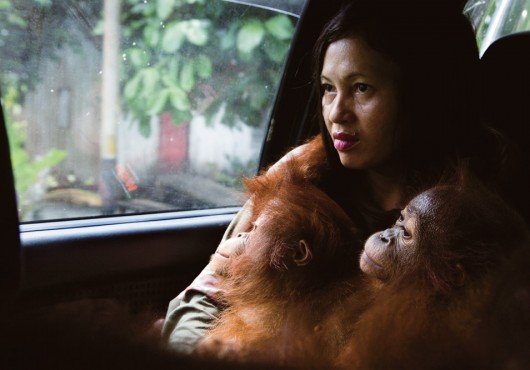 Forced eviction, forced immigration
Orang-Utan orphans fleeing their ravaged parents and their ravaged ancestral homes
Forced eviction, forced immigration
Orang-Utan orphans fleeing their ravaged parents and their ravaged ancestral homes
Present us an American citizen accepting of such home eviction!
.
ED: Cargill’s eco-rape and eco-plunder policy across Indonesia’s vulnerable Borneo (Kalimantan) demonstrates that Cargill’s above public relations spiel is clearly crap! This is a wealthy United States corporate exploiting a poor country’s precious rainforest ecosystems, buggering local indigenous peoples and driving the extinction of the endangered Orang-Utan. If you work for Cargill or have shares in Cargill yoiu may as well be associated with the arms suppliers to the Syrian president Bashar al-Assad and his regime.
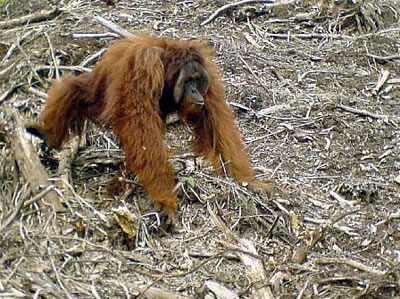 Not just home invasion, but complete ecological erasion
Cargill is calling in the A-Bomb to Orang-Utans
What United States citizen would tolerate this?
911 is being inflicted on vulnerable species by the United States Not just home invasion, but complete ecological erasion
Cargill is calling in the A-Bomb to Orang-Utans
What United States citizen would tolerate this?
911 is being inflicted on vulnerable species by the United States
.
.
 Cargill’s worldwide president and COO Gregory R. Page
His life won’t end in devastation, but he drives devastation in vulnerable Kalimantan – in secret! Cargill’s worldwide president and COO Gregory R. Page
His life won’t end in devastation, but he drives devastation in vulnerable Kalimantan – in secret!
.
Further Reading:
.
[1] ‘Villagers face off against palm oil firm’s bulldozers‘, by EIA, 20111123, ^http://www.eia-international.org/villagers-face-off-against-palm-oil-firms-bulldozers
.
[2] ‘Orangutan ‘killers’ on trial over slaughtering primates for pest control at palm oil plantation‘, by Damien Gayle, Daily Mail, 20120208, ^http://www.dailymail.co.uk/news/article-2097946/Orangutan-killers-trial-slaughtering-primates-pest-control-palm-oil-plantation.html
.
Tags: ancient rainforest, Cargill, deforestation, deforestation in Indonesia, EIA, Environmental Investigation Agency, forest exploitation, Gregory R. Page, Gusti Hatta, Hillary Clinton, Indonesia, Indonesian palm oil plantations, Kalimantan, Logging, logging Borneo, Meranti, Murara Tae, orang-utan, palm oil, palm oil plantations, payang tree, President of Indonesia, PT Borneo Surya Mining Jaya, PT Munte Waniq Jaya Perkasa, Sumatran logging, Surya Dumai, Susilo Bambang Yudhoyono, Telapak, Ulin, United States
Posted in Kalimantan (ID), Orang-utans, Threats from Farming | No Comments »
Add this post to Del.icio.us - Digg
Monday, February 20th, 2012
 “Let us bind ourselves tightly to the Sorrowful Heart of our Heavenly Mother and reflect on it’s boundless grief and how precious is our soul.” “Let us bind ourselves tightly to the Sorrowful Heart of our Heavenly Mother and reflect on it’s boundless grief and how precious is our soul.”
~ Saint Padre Pio
.
Kangaroo meat involves live castration. Would you like red wine, pear juice and cranberry jelly with that?
The following video confirms Australia’s rural culture encouraging a psycho-sadistical and brutal hate towards wildlife.
It could be of elephants or rhinos in Africa, it could be Nazi Germany or Poland, or Rwanda or Serbia, but it is rural Australia and its precious wildlife. It is 19th Century depraved sadism and kangaroo slaughter is condoned by Julia Gillard’s Australian Government. This is how rural Australian shooters treat wildlife, like Japanese fishermen treat dolphins at Taiji.
It is akin to the teenage deviantism of Tasmanian mass murderer Martin Bryant and straight out of the film Wolf Creek .
.
WARNING: This video is extremely disturbing and not suitable for children. But it needs to be made public! In 2012 it reflects the callous reality of rural Australia. No wonder urban Australia turns its back on rural Australians and starves them of funding – such sadists only deserve an eye for an eye.
Click to view video:
.
Honesty, I could not inflict such callousness on any sentient being.
But if I was sure of the culpability of such a monster, wildlife thereafter would have no fear.
.
Tigerquoll
Suggan Buggan
Snowy River Region
Victoria 3885
Australia
Tags: holy mary, kangaroo meat, kangaroo slaughter, kangaroo slaughter for fur, kangaroos, Martin Bryant, rural Australia, Taiji, tigerquoll, wildlife slaughter, Wolf Creek
Posted in Kangaroos and Macropods, Threats from Poaching and Poisoning | No Comments »
Add this post to Del.icio.us - Digg
Saturday, February 18th, 2012
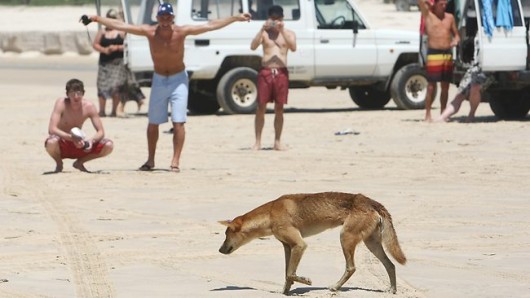 No place for feral tourists on World Heritage Fraser Island No place for feral tourists on World Heritage Fraser Island
.
Remove all ferals from Fraser Island – rabbits, cats, brumbies, gambusia, cane toads, 4WDs, tourists and tour operators!
It’s time to reverse the tables. I’d like to see these exploiters racing towards catastrophic collapse instead of the native dingos – and for any trangressions automatically attract a minimum $200,000 fine and/or 6 months in gaol.
Shut down the Fraser Island Ferry Service and Manta Ray Fraser Island Barge service – pay the ferrymen compensation to retire happily.
Shut down Kingfisher Bay Resort – pay the operator out to retire happily, then convert it into a proper National Parks wildlife research station.
 Such 20th Century resort tourism is inappropriate for World Heritage Fraser Island Such 20th Century resort tourism is inappropriate for World Heritage Fraser Island
.
Fraser Island is a National Park. It is world heritage listed by crikes, not as a tourism promotion, but for its ecological values. The place is endangered, the pure native dingo is on its last legs and suffering at the hands of humans, so number one priority of a national park is ecological protection. National Parks Service needs to get its nose out of tourism exploitation and bush arson and back into its job of wildlife ecology management. But it needs to be managed at national level, because the Queensland DERM cowboys can’t be trusted.
There is no reason why the custody of the entire island should not be returned to the traditional Butchulla and Badtjala peoples to oversee the rehabilitatiin and ecological management.
Indeed, Fraser Island should renamed back to the respective indigenous names: K’gari and Gari.
It is time to get serious about ecology. Simple solution, just takes community will and leadership, like in the 1970s grassroots campaign to originally protect the island from Joh’s sand mining pillage.
Get the tourists off Fraser Island. Shut down Base Camp Fraser Island, shut down Eurong Beach Resort, shut down Fraser Island Beach Houses, Fraser Island Fishing Units, Fraser Island Hideaway, Fraser View Apartments, Cathedrals on Fraser camping ground, Fraser Island Waiuta Retreat. Compulsorily acquire their land holdings and put them on the last tourist ferry off the island.
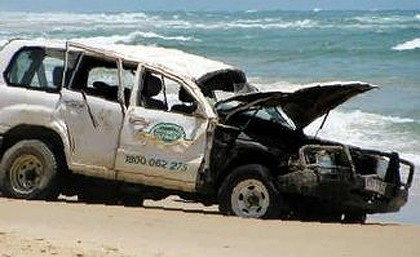 4WD tourist hoons on Fraser Island in 2009
[Source: ‘Overseas tourists drive up Fraser Island 4WD carnage’,
by Tony Moore and Cameron Atfield, Brisbane Times, 20091215,
^http://www.brisbanetimes.com.au/travel/travel-news/overseas-tourists-drive-up-fraser-island-4wd-carnage-20091214-ks6f.html] 4WD tourist hoons on Fraser Island in 2009
[Source: ‘Overseas tourists drive up Fraser Island 4WD carnage’,
by Tony Moore and Cameron Atfield, Brisbane Times, 20091215,
^http://www.brisbanetimes.com.au/travel/travel-news/overseas-tourists-drive-up-fraser-island-4wd-carnage-20091214-ks6f.html]
.
. 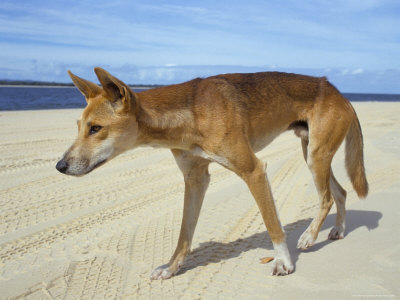 Pure Dingo
Threatened, harrassed on its native Fraser Island Pure Dingo
Threatened, harrassed on its native Fraser Island
.
Last April 2011, three Fraser Island dingo pups were destroyed (read ‘executed‘) in as many weeks after displaying aggressive behaviour towards humans, according to the Department of Environment and Resource Management (DERM). DERM general manager Terry Harper said three dingoes from the June/July 2010 litters had “posed a clear threat”’ to the safety of visitors and the community. Fraser Island is the dingos native home. The tourists are feral intruders and the problem, not the dingos. Harper needs to be sacked.
[Source: ‘Three more Fraser Island dingoes destroyed after aggressive behaviour toward campers’, by Kristin Shorten, The Courier-Mail, 20110428, ^http://www.couriermail.com.au/news/queensland/three-more-fraser-island-dingoes-destroyed-after-aggressive-behaviour-toward-campers/story-e6freoof-1226046070071]
.
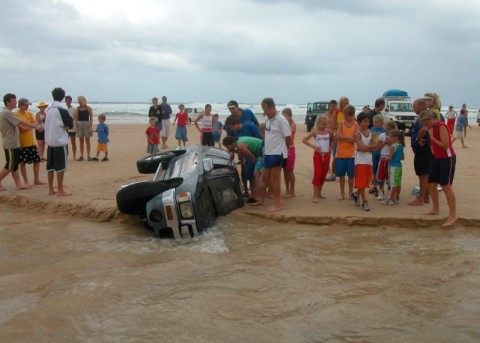 Say no more! Say no more!
.
Bree Jashin of the Fraser Island Dingo Preservation Group says tourists feeding and teasing dingoes on Fraser Island could lead to the extinction of the native dogs on the island. Ms Jashin provided AAP with a photograph of tourists kicking sand at dingoes and a first-hand account of another incident between tourists and a dingo pup, which she said could elicit a reaction and lead to the dingo’s destruction by rangers.
“The right for humans to play at the expense of the future of the only thoroughbred dingoes left is unacceptable,” Ms Jashin said. “Fraser Island is the dingoes’ home and humans have to remember they are guests in that home.
Chris Druery was among a group of three visitors in a four-wheel-drive south of Eli Creek on Fraser Island on October 1 last year when they saw an approaching vehicle drive directly towards a dingo pup.
“[The driver] pointed their vehicle directly towards the pup and sped up, attempting to run it down,” Mr Druery said. “They also swerved violently towards the pup, missing it by only centimetres. “We watched the pup cower and run towards the surf with its hind legs tucked up under its rear end.”
Mr Druery said those in the offending four-wheel-drive were laughing during their attempts to run the dingo down. “It is disappointing that such a jewel in the crown can be tarnished by clowns that drive dangerously on the beach,” he said.
Ms Jashin said the three dingoes in photographs she snapped last year were heading towards Eurong township beachfront when they were harassed by backpackers.
“The pups were simply minding their own business when the girls screamed and the young male backpacker began to aggressively yell, run at, and kick sand at the pups,” she said.
Rather than dissuade the dogs, the yelling attracted them towards the group. “The backpackers all jumped in the vehicle and drove up close to them to take pics,” she said. She said all three of the pups had been destroyed after exhibiting allegedly aggressive behaviour towards humans.
[Source: ‘Tourists ‘threatening dingo extinction’, by AAP, 20100317, ^http://www.smh.com.au/environment/conservation/tourists-threatening-dingo-extinction-20100317-qe1o.html].
.
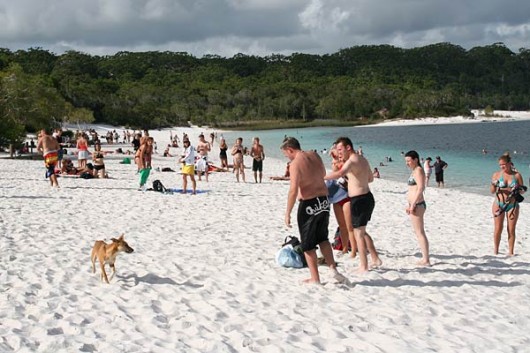 Uncontrolled tourist interation with Fraser Island’s wild dingoes
Tourists and wildlife don’t mix – when will Parks Management get the message ?
DERM is not a tourist operator. Fraser Island is a World Heritage National Park for wildlife. Uncontrolled tourist interation with Fraser Island’s wild dingoes
Tourists and wildlife don’t mix – when will Parks Management get the message ?
DERM is not a tourist operator. Fraser Island is a World Heritage National Park for wildlife.
.
Fraser Island is a wildlife World Heritage sanctuary, not another Hamilton Island Resort!
.
Last September 2011, some bored National Parks officers decided to start a fire on the island. They excused it as a ‘controlled burn’, but is is arson no less and surprise surprise, it got out of control. “It was going for five or six days, and the weather changed and it took off in a different direction, unfortunately. “These things are part of life. In most national parks you need to reduce the fuel load.”
The vandals need to be sacked (including the manager for probably inciting it) banned from Fraser Island and fined for the cost of the emergency response by the 18 fire fighters from Rural Fire Brigade, Queensland Fire and Rescue Service and the 4 waterbombing aircraft.
[Source: ‘A resort on Fraser Island is threatened by a grass fire, which appears to have started with a controlled burn’, by AAP, 20111003, ^http://www.theaustralian.com.au/news/nation/a-resort-on-fraser-island-is-threatened-by-a-major-grass-fire/story-e6frg6nf-1226156969941]
.
Queensland’s Fraser Island was inscribed on the World Heritage List in 1992 after nearly twenty years battle and public debate.
Once it was listed, the Queensland Government has maliciously abused the world heritage for tourism and recreation, allowing the precious island to become so degraded that some people are now arguing that it needs to be placed on the World Heritage in Danger List. (Ed: It should be, right now).
‘It isn’t that Fraser Island lacks the values that warranted its World Heritage listing in the first place. It is just that the management values for Fraser Island are pre-occupied with recreation Management to the neglect of the protection of its World Heritage values.
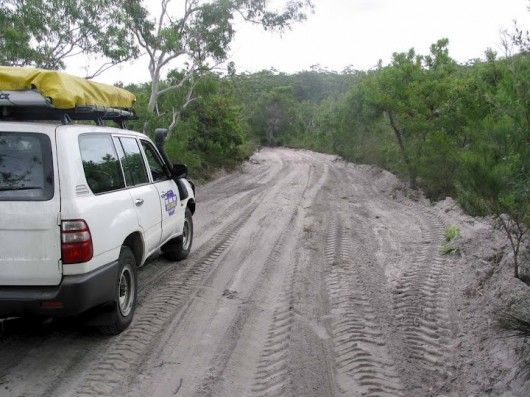 Unmonitored 4WDs
A bit of road widening into Fraser Island’s vegetation Unmonitored 4WDs
A bit of road widening into Fraser Island’s vegetation
.
On Fraser Island ‘bevans‘ rule ok!
‘On Fraser Island 4WD recreational vehicles rule all policy decisions even though environmental studies have conclusively shown the impact of the 4WDs in compacting sand in the substrate and thus accelerating water erosion. The mobilization of sand as a result of this means that over a three year period more than a million tones of sand has been mobilized and sluiced down the slopes. That means over a tonne of sand it relocated for every visitor to Fraser Island!
‘Some roads are now scoured down to a depth of 4 metres and they continue this on-going down-cutting every time it rains. As little as 5mm of rain is more than enough to start mobilizing surface sand on roads. Some of the sand is deposited lower down the slopes; other sand is being sluiced into the iconic perched dune lakes.
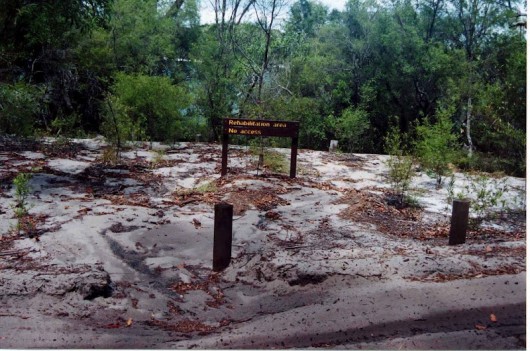 Road to McKenzie – the Parks Service must have gone AWOL Road to McKenzie – the Parks Service must have gone AWOL
.
Some of the sand is deposited so that picnic tables begin to get buried and other picnic spots are being scoured out demonstrating the fragility and mobility of any disturbed soil surface on Fraser Island.
‘In 1963 Indian Head had a lawn of thick grass extending right to its summit. Since then the unprotected surface soil has been disturbed but hundreds of thousands of feet. This has been eroded and washed away by rain exposing an ever expanding area of bare rock. There are no plans to repair the damage or rectify this problem in the foreseeable future.
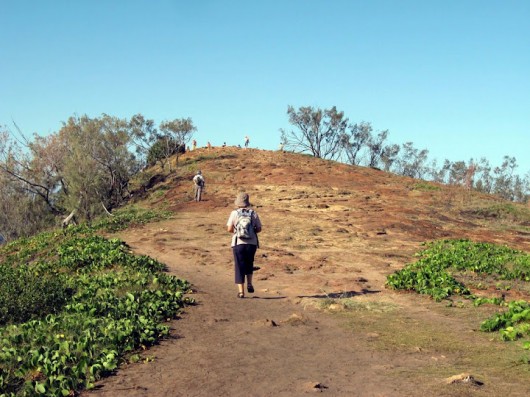 Indian Head degradation by excessive uncontrolled tourism.
Where are DERM Parks Management – off lighting grass fires?
. Indian Head degradation by excessive uncontrolled tourism.
Where are DERM Parks Management – off lighting grass fires?
.
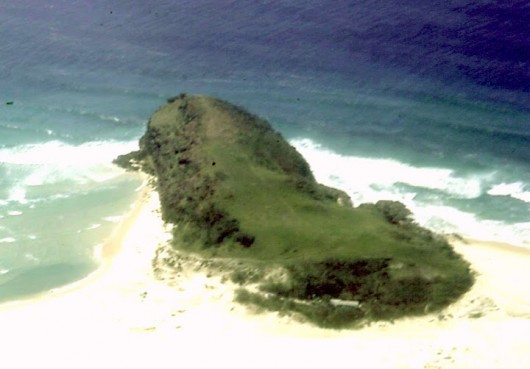 Indian Head vegetation back in 1974 Indian Head vegetation back in 1974
.
‘A disproportionate amount of the budget is spent on recreational facilities, visitor safety and management, waste management. Road widening and upgrading has become an obsession. This focus has led to the neglect of research and the natural resource management, — environmental monitoring of wildlife and ecosystems, fire management, weed control, and quarantine.’
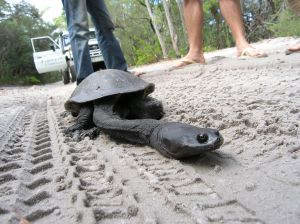 Fraser Island’s native long-necked turtles
vulnerable to 4WD hoons Fraser Island’s native long-necked turtles
vulnerable to 4WD hoons
.
‘The preoccupation with recreation management on Fraser Island is encouraging more and more visitors to visit Fraser Island in unsustainable ways. Recreation is degrading Fraser Island’s World Heritage values including its iconic lakes. Recreation management is at the expense of managing the island’s natural resources. These suffer from lack of adequate monitoring. No monitoring of the water quality in the lakes was done for a decade while road run-off continues to pour into the lakes impacting on water quality.’
 Ongoing sand dune damage by unmonitored 4WDs
Tourist access on Fraser Island has become a free-for-all ! Ongoing sand dune damage by unmonitored 4WDs
Tourist access on Fraser Island has become a free-for-all !
.
Fraser Island has less than one kilometre of boardwalks. Queensland government policy prevents any feasibility into developing an environmentally more sustainable light rail people mover there. Yet compared with Gunung Mulu National Park in Malaysia, listed eight years after Fraser Island, with exactly a tenth of the visitor number of Fraser Island puts Fraser Island management to shame.
[Source: ‘Queensland’s shameful management of the Fraser Island World Heritage site‘, by John Sinclair, 20100702, ^http://randomkaos.com/node/14, (John Sinclair is one of Australia’s leading nature conservationists and has lead the fight to save Fraser Island since 1971 when he founded the Fraser Island Defenders Organisation)]
.
In 2007 an Irish backpacker tourist, Evan Kelly, while on Fraser Island thought it was a good idea to run down a sand dune into Lake Wabby. He did this several times then landed head first in the lake, hurt his back then sued the Queensland Government and the backpacker hostel, Pippies Beach House, for failing to warn him of the dangers.
Previously in 2006, tourist Su Chul Jang from South Korea, decided to run down a sand dune and dive into Lake Wabby, but became a quadriplegic and sued the tour company Fraser Escape 4×4 Tours Pty Ltd and the Queensland Government.
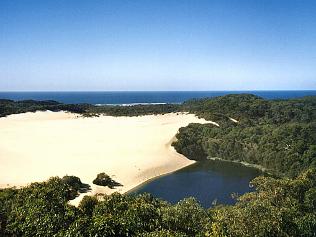 Leave Lake Wabby alone! Leave Lake Wabby alone!
.
[Source: Fraser Island backpacker sues Queensland Government, tourism operators for injuries at Lake Wabby’ by Kay Dibben, The Sunday Mail (Qld), 20100829, ^http://www.couriermail.com.au/news/queensland/fraser-island-backpacker-sues-queensland-government-tourism-operators-for-injuries-at-lake-wabby/story-e6freoof-1225911278600]
.
What’s the full cost of Fraser Island tourism?
.
The Queensland Government’s World Heritage management of Fraser Island has been called into question internationally over claimed incompetence and malice.
Opposition Shadow Sustainability Minister Glen Elmes said he had “taken steps to ensure that UNESCO, the organisation charged with overseeing World Heritage listed areas, has been advised of the island’s plight”. He described island management as “incompetent at best” and a betrayal of state government conservation obligations.
Mr Elmes accused her Department of Environment and Resource Management of a major cover-up of mismanagement, environmental damage and “ruthless and cruel” policies on dingo management. Mr Elmes told Parliament this week that he had read the report, estimating the death of 97 dingoes from causes listed in autopsy reports as “lethal injection, shot, run over, poisoned, starvation and others”.
“One autopsy lists under possible cause of death, ‘rifle-itis,’ while another states ‘half an ounce of hot lead,” he said. “Labor’s interim report shows happy snaps of a dingo family, dingoes on the beach, dingoes frolicking in the water, a dingo running up the beach with a fish in its mouth. “On a normal day, those dingoes would be hazed by rangers – that is shot with a clay pellet, moving them away from the beach and away from their main food source,” he said.
[Source: Claims of Fraser Island ‘cover-up’ by Arthur Gorrie, 20100902, ^http://www.gympietimes.com.au/story/2010/09/02/Fraser-Island-cover-up-claimed/]
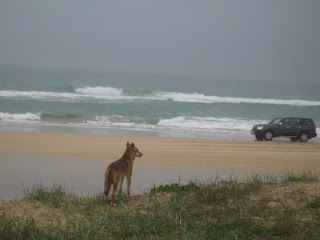
.
Meanwhile the Queensland Labor Government’s only interest for Fraser Island is more tourism development.
In September 2010, Federal Labor Environment Minister Tony Burke and Queensland’s Bligh Labor Government’s Climate Change and Sustainability Minister Kate Jones opened a joint $3.4 million tourist facilities at Lake McKenzie on Fraser Island.
.
“This is great for tourism on the island and great news for the Hervey Bay economy.”
~ Kate Jones’ 20th Century mindset for world heritage.
.
Labelling it “eco-friendly”, the modern facilities include:
- More vehicle access routes
- A bigger car park
- Wider pedestrian access to the beach
- More toilets
- More viewing platforms
- Improved signage
- Oh and extensive site revegetation. Nice.
.
[Source: ‘Ministers officially open major upgrade to facilities at Lake McKenzie’ (Labor joint media release), 20100923, ^http://www.environment.gov.au/minister/burke/2010/mr20100923.html]
.
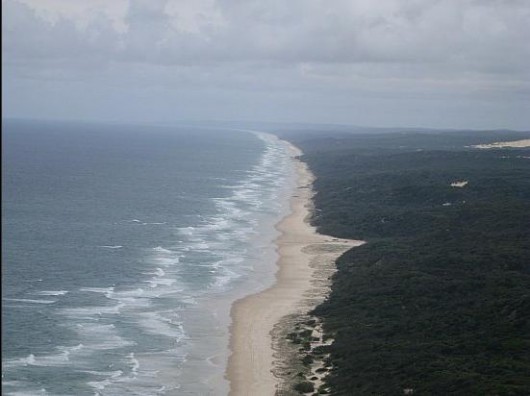 Fraser Island’s 75 Mile Beach
…clear of ferals of all types Fraser Island’s 75 Mile Beach
…clear of ferals of all types
.
It is time to place Fraser Island on the World Heritage in Danger List, get all the ferals including the tourists and their profiteers off the island and to commence the job and investment of serious World Heritage management of one of the planet’s remaining important nature assets.
.
Tigerquoll
Suggan Buggan
Snowy River Region
Victoria 3885
Australia
 Lake Boomanjin on Fraser Island,
Supposedly protected
(Photo by Steven Nowakowski, click photo to enlarge) Lake Boomanjin on Fraser Island,
Supposedly protected
(Photo by Steven Nowakowski, click photo to enlarge)
.
Further Reading:
.
[1] ‘ Queensland’s shameful management of the Fraser Island World Heritage site‘, by John Sinclair, 20100702, ^ http://randomkaos.com/node/14, (John Sinclair is one of Australia’s leading nature conservationists, has lead the fight to save Fraser Island since 1971 when he founded the Fraser Island Defenders Organisation).
.
[2] ‘ Fighting Ferals on Fraser Island‘, by Fraser Island Defenders Organization (FIDO) “The Watchdog of Fraser Island”, aims to ensure the wisest use of Fraser Island’s natural resources, ^ http://www.fido.org.au/education/FightingFerals.html
.
Wednesday, February 1st, 2012
It’s a remarkable photograph: A pregnant Orang-utan protectively clutching her five-year-old child as death seems imminent at the hands of bounty hunters armed with knives.
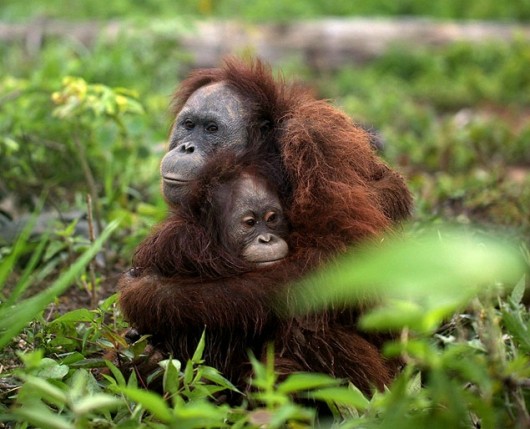 Ordeal…the mother and baby Orang-utan, above, were lucky to have escaped
a group of juvenile Indonesian poachers (below) in Kalimantan (Borneo)
(© Photo by Vier Pfoten of Four Paws International, ^http://www.four-paws.org.uk/ and Ordeal…the mother and baby Orang-utan, above, were lucky to have escaped
a group of juvenile Indonesian poachers (below) in Kalimantan (Borneo)
(© Photo by Vier Pfoten of Four Paws International, ^http://www.four-paws.org.uk/ and
PT Restorasi Habitat Orangutan Indonesia (RHOI)
^http://forest-carbon.org/project-list/first-project)
.
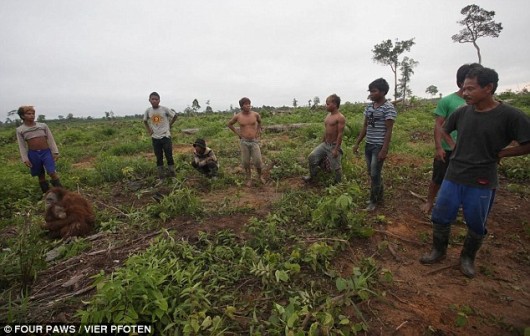
At The Habitat Advocate we wish to emphasise and thank the vital role of wildlife photographers around the world whose photos continue to help convey the plight of wildlife at the hands of humans. Without such photos, the truth would be less disseminated.
The following article was reproduced in The Sun-Herald newspaper (Sydney) on 20120129 on page 30. The article was borrowed from the New York Daily News newspaper (New York) which published the article on 20120127. The original source was the Daily MAIL (UK), written by Richard Shears, 20120127, under the long heading: ‘Don’t hurt my baby! Pregnant Orang-utan protectively hugs her daughter as ruthless Borneo bounty hunters move in for the kill‘.
The ultimate source is from the website of Four Paws UK.
Four Paws International is an international animal charity, campaigning to end animal suffering and cruelty. Four Paws International was founded in 1988 in Austria to campaign against fur farms and against battery farmed eggs.
Visit their website (English office) : ^http://www.four-paws.org.uk/
The partner organisation based in Indonesia is PT Restorasi Habitat Orang-utan Indonesia (RHOI), which translates into English as the Borneo Orang-utan Survival (BOS). Its name could not be more literal! Humans are systematically exterminating a species – the Orang-utan.
BOS has developed an Ecosystem Restoration Concession with the intention of using the forest area as a release site for rehabilitated Orang-utans. The proposed concession is in East Kalimantan is comprised of the ex-PT Mugitriman International (MGI) timber concession. BOS would like to obtain sustainable funding for managing and safeguarding this forest and is currently exploring the option of an avoided deforestation/REDD project where the sale of carbon.
Visit their website: ^http://forest-carbon.org/project-list/first-project
.
.
‘Pregnant Orang-utan mother and child rescued at last minute from knife-bearing bounty hunters in Borneo’,
by Rolando Pujol in the New York Daily News, Friday, 20120127, ^http://www.nydailynews.com/news/pregnant-orangutan-mother-child-rescued-minute-knife-bearing-bounty-hunters-borneo-article-1.1013270?]
.
It’s a remarkable photograph: A pregnant Orang-utan protectively clutching her five-year-old child as death seems imminent at the hands of bounty hunters armed with knives.
At the last minute, however, members of Four Paws International, an international animal-rescue group, swooped in last week and prevented their killings in Borneo, the Daily Mail reported.
“A few minutes later and the Orang-utans could have been dead,” said Dr. Signe Preuschoft, a primate expert with the British-based organization, according to the Daily Mail. “We discovered a gang of young men surrounding them and both victims were clearly petrified.”
The incident showcases the threat Orang-utans are facing as they are targeted for slaughter with a price on their heads.
“The gang meanwhile were jubilant in anticipation of their rewards for catching and killing the animals.”
The incident, compellingly captured in a dramatic photo of the mother cradling her child for dear life, casts a fresh light on the disturbing plight of Orang-utans, who were once common throughout Southeast Asia but now mostly live in Borneo and other areas in Indonesia.
The mother, estimated to be between 25 and 30, and the child were the only Orang-utans the team found alive in the area surrounding a palm-oil plantation. The group said it was scouting the area after reports of mass Orang-utan slaughter.
The spread of palm oil plantations, the group said, is accelerating the demise of the already endangered animals, which are losing native habitat because of widespread deforestation. The very name Orang-utan means “person of the forest,” as they spend most of their time in trees.
.
The palm-oil companies, the group said, are allegedly making matters worse by offering rewards of about $100 per dead Orang-utan, because they see the animals as nuisances.
.
“These massacres must not be allowed to continue,” Preuschoft said to the Daily Mail.
The rescued animals have since been released back in the wild in an area far from where they almost met death. The mother was fitted with a radio transmitter to help ensure the apes stay safe, the group said.
“Tens of thousands of adult Orang-utans have been slaughtered, while their orphaned offspring is frequently being sold off as pets or left behind to die, if they aren’t killed on the spot as well“, Four Paws International posted on its website.
The slaughter of Orang-utans is illegal in Indonesia, but enforcement has stepped up only recently, the group said.
“Mass graves that were discovered last September triggered the first few serious arrests, including a senior plantation manager“, the group wrote.
.
A similar article (in more detail) by the Daily Mail (UK):
.
‘Don’t hurt my baby! Pregnant Orang-utan protectively hugs her daughter as ruthless Borneo bounty hunters move in for the kill’
[Source: ”Don’t hurt my baby! Pregnant Orang-utan protectively hugs her daughter as ruthless Borneo bounty hunters move in for the kill’, by Richard Shears, 20120127, Daily Mail (UK), ^http://www.dailymail.co.uk/news/article-2092722/Pregnant-orang-utan-hugs-daughter-bounty-hunters-Borneo-in.html]
.
- Pair saved at last minute by UK-based animal rescue group
- Palm oil firms trying to clear plantations said to be offering £70 for each Orang-utan killed on the Borneo palm oil plantations
.
As bounty hunters with bush knives entrapped them in a circle and moved in for the kill, the only thing this mother Orang-utan could think to do was to wrap a giant protective arm around her daughter. The pair seemed to be facing a certain death as a gang of hunters surrounded them in Borneo, keen to cash in on the palm oil plantations’ bid to be rid of the animals.
But, happily, a team from the British-based international animal rescue group Four Paws International arrived in time to stop the slaughter and saved their lives.
The pregnant mother and daughter were captured and moved to a remote and safe area of the rainforest and released back into the wild – but not before the mother was equipped with a radio device so she and her young can be tracked to ensure they remain safe.
‘Our arrival could not have been more timely,’ said Dr Signe Preuschoft, a Four Paws primate expert. ‘A few minutes later and the Orang-utans could have been dead.’
‘We discovered a gang of young men surrounding them and both victims were clearly petrified.
‘The gang meanwhile were jubilant in anticipation of their rewards for catching and killing the animals. These massacres must not be allowed to continue.’
Saved: ‘Our arrival could not have been more timely. A few minutes later and the Orang-utans could have been dead’ said Dr Signe Preuschoft, a Four Paws primate expert
‘A few minutes later and the Orang-utans could have been dead.’ said Dr Signe Preuschoft, a Four Paws International primate expert
Mother and daughter were captured and moved to a remote and safe area of the rainforest and released back into the wild – but not before the mother was equipped with a radio device so she and her young can be tracked to ensure they remain safe.
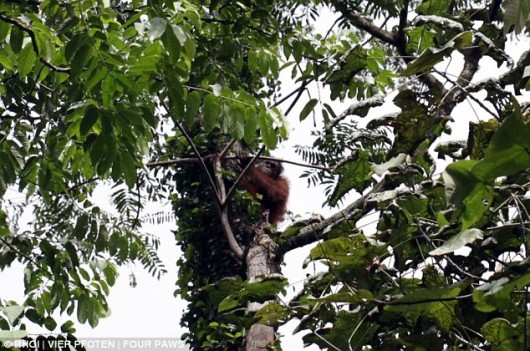 Mother and baby rescued and placed into the wild.
But with their rainforest wilderness rapidly being destroyed how long have these Orang-utans got? What happened to the father? Mother and baby rescued and placed into the wild.
But with their rainforest wilderness rapidly being destroyed how long have these Orang-utans got? What happened to the father?
.
Before the rescue, a Four Paws International team had scoured the area on the Indonesian side of Borneo, which is shared with Malaysia, but found no other Orangutans which had survived an earlier slaughter.
.
Deforestation has dramatically reduced their habitat and their numbers have dropped from 250,000 a few decades ago to only 50,000 in the wild. And while the loss of their habitat by logging companies has created a major threat to their existence, a more brutal form of reducing their numbers has emerged in recent years – direct slaughter.
.
Palm oil is used in hundreds of products from chocolate to oven chips, but the demand for buying it at a low price has resulted in significant deforestation as habitats are being destroyed to make way for plantations. Some palm oil companies see Orang-utans as pests, a threat to their lucrative business, and have placed a bounty on their heads.
Company executives are reported to be offering up to £70 to employees for each Orang-utan killed on the palm oil plantations. While such stories were at first denied, proof of the slaughter emerged last September when graves and bones were found by investigators.
‘Killing of Orang-utans is illegal in Indonesia but the law is lacking enforcement,’ said a Four Paws UK spokesman.
‘Before November last year only two low-level arrests had ever been made. But in the last two months 10 more arrests have taken place including the arrest of the senior manager of the plantation where the worst graves have been found.’
In an equally tragic scenario, babies left alive after adult Orang-utans have been slaughtered have been put up for sale in the Pet Trade by hunters.
When traumatised babies are found by Four Paws International and other animal rescue teams they are taken to a sanctuary and taught skills they will need in order to return to the wild.
.
.
Selected comments from readers:
.
‘Boycott any product with palm oil!!!’
~ maninthemiddle, 20120128.
.
“Let’s find the corporate entities who are paying for the palm oil,then boycott,very sad story,very touching”
~ olefan_is_a_moron, 20120128.
olefan_is_a_moron (20120128):.
“The real problem in the world is overpopulation. Natural resources replace themselves unless they are overburdened by excessive demand due to a big population. Cutting down 1% of a forest will not harm it since trees will just grow back but when you’re destroying too much at once you’re just striping the land bare.”
~ DocPaul (20120128)
.
“Soon man shall be the only “animal” left for hunting.”
~ 3 VULTURES (20120128).
.
“Orang-utans are critically endangered in the wild because of rapid deforestation and the expansion of palm oil plantations into their rainforest home. The situation described in this article is all too common unfortunately. If nothing is done to protect these amazing creatures, they will be extinct in just a few years. Visit the Orangutan Outreach website to learn more and make a difference! http://redapes.org Reach out and save the orangutans! Adopt an orangutan today! {:(|}”
~ OrangutanOutreach (20120128).
.
“How about a bounty of $150 per dead bounty hunter?”
~ Meowmeister, 20120128.
.
“This is what happens when you have: 1. People believing that the so-called phrase “and man shall have dominion over the beasts” means they can be killed at will and 2. When human beings believe nothing absolutely nothing is more important than profit.”
~ itsallinperception, 20120128.
.
“Farmers are being killed in south America for the same reason, land. Plantation owners want the land to get money for carbon credits…”
~ nlohu, 20120128.
.
“So sad. Palm oil is not just used in food. It is also used in cosmetics. I think it is called retinyl palmitate, something like that. Any ingredient that has “palmitate (ie: palm) is from palm oil. It is a form of vitamin A, used in skin creams alot.”
~ ana63, 20120128.
.
“These companies should not be allowed to trade in the UK. We shouldn’t be trading with any company that doesn’t respect life and the environment.”
~ Lo, cheshire, UK, 20120128.
.
“Everything that is wrong with the world is due to humans. We will continue to destroy our world unless something radical happens to reduce the human population and to change the greedy mindset of the human population. This makes me so incredibly sad!”
~ GB, UK, 20120128.
.
“…I think what would be more helpful is to have the names of the food manufacturers who are purchasing the palm oil from those companies. I suspect we would see major names such as Nabisco, Kraft, etc.”
~ InfoOverload, 20120128.
.
.
ANSWER: The largest palm oil company worldwide is ‘Wilmar International’
.
One of the most powerful opponents of our ‘Save our Borneo’ activists is Wilmar International, the largest palm oil company worldwide, based in Singapore.

“Wilmar International Limited, founded in 1991, is Asia’s leading agribusiness group.
“We are amongst the largest listed companies by market capitalisation on the Singapore Exchange. Our business activities include oil palm cultivation, oilseeds crushing, edible oils refining, sugar, specialty fats, oleochemicals and biodiesel manufacturing and grains processing. Headquartered in Singapore, Wilmar has over 300 manufacturing plants and an extensive distribution network covering China, India, Indonesia and some 50 other countries to support a well established processing and merchandising business. Wilmar also manufactures and distributes fertilisers and owns a fleet of vessels. The Group is backed by a multi-national workforce of approximately 90,000 people.”
“We are today:
- The largest global processor and merchandiser of palm and lauric oils
- One of the largest plantation companies in Indonesia/Malaysia
- The largest palm biodiesel manufacturer in the world
- A leading consumer pack edible oils producer, oilseeds crusher, edible oils refiner, specialty fats and oleochemicals manufacturer in China
- One of the largest edible oils refiners and a leading producer of consumer pack edible oils in India
- The largest edible oils refiner in Ukraine
- The leading importer of edible oils into East Africa and one of the largest importers of edible oils into South-east Africa.
‘We will continue to leverage on the scale and strengths of our business model to benefit from the long term growth potential of the agricultural commodity business, especially in Asia.”
Visit website: ^http://www.wilmar-international.com/
.
.
Cyclone Yasi 2011 destruction sees Wilmar take over Australia’s CSR’s Sucrogen
.

[Source: ‘ Proserpine creditors approve sale of mill to Sucrogen‘, 20111209, ^ http://www.sucrogen.com/media/news]
.
‘Sucrogen, the Australian-based sugar subsidiary of Singapore-listed Wilmar International Limited, looks forward to an exciting future as the new owner of Proserpine Sugar Mill after a majority of Proserpine creditors, by number and value, voted today to approve Sucrogen’s purchase of the mill.
Sucrogen CEO Ian Glasson said the creditors’ vote was a great outcome and paved the way for the sale transaction to be completed immediately.
“The positive result means creditors will be paid, in full, before Christmas,” Mr Glasson said. “We are grateful to have received such strong support from creditors, who have clearly shown faith in us and our plans for the Proserpine region.”
Sucrogen’s offer comprised a headline price of A$120 million, plus a working capital adjustment, normal settlement adjustments, as well as absorption of the mill’s normal operating costs and certain critical capital expenditure incurred from 31 October 2011.
Mr Glasson said while Sucrogen was pleased to finally purchase the mill, it was disappointing the sale was not possible before the Co-operative was placed into voluntary administration.
“The negative campaign Tully ran to derail the first two member votes has, ultimately, cost members a substantial amount of money in administration and legal fees,” he said. Critically, it has also delayed capital and maintenance at the mill.”
However, the transition to Sucrogen management and leadership will begin immediately and we will hit the ground running next week and do our best to ensure the mill is ready for the start of 2012 season, despite the lengthy delays.”
Mr Glasson said Wilmar had expressed a strong interest in working with growers to help expand Proserpine’s sugar industry.
“We look forward to a long and productive relationship with local growers, Proserpine Sugar Mill employees and the whole Proserpine community.”
.
So the company that is behind the palm plantation clearing destroying Orang-utan habitat and encouraging Oran-gutans to be slaughtered, is the parent company that sells CSR Sugar across Australia and Chelsea Sugar across New Zealand and the artificial sweetener ‘Equal‘.


.
.
The palm oil industry says: ‘Orang-utans are pests!’
[Source: ^http://www.rainforest-rescue.org/newsletter/1267/282c3e5ec03e375e7afa82c63564ae41]
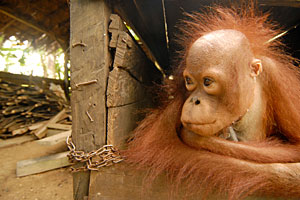 This juvenile Orang-utang’s mother was killed on one of the palm oil plantations This juvenile Orang-utang’s mother was killed on one of the palm oil plantations
.
“Dear friends of the rainforest, the BBC reports that Orang-utans are treated as “pest” and exterminated on Indonesian and Malaysian palm oil plantations. In the last year alone, up to 1,800 Orang-utans were killed in Kalimantan (Indonesian Borneo). They wander hungry through the plantations as though in a daze, looking for food and thus eat the palm seedlings. Palm oil plantation workers are paid to kill Orang-utans either before a forest is cleared or, if they see any in a plantation. Either way, it is totally illegal to harass, harm or kill any Orang-utans.”
[Source: ”Borneo: Environmentalists need help for preserving the rainforest’, ^https://www.rainforest-rescue.org/donate/90/borneo-environmentalists-need-help-for-preserving-the-rainforest]
.
“The current trend of converting rainforest into palm oil plantations is devastating our country. Our people cannot provide for themselves any longer; and endangered species such as the Orang-utans are doomed to die. It is high time for us to join forces and jointly put a stop to the palm oil industry’s illegal activities on all levels.“
Nordin, head and founder of our partner organisation ‘Save our Borneo’ (SOB) has lately experienced a great deal of suffering caused by the destruction of tropical rainforest in his home province Central Kalimantan in Borneo – including his own family. His little son Mirza was born when wildfires were raging for several months, obscuring the sky over Central Kalimantan and making breathing truly agonizing. Due to his chronic breathing difficulties, Mirza had to be hospitalised often. Even though slash and burn clearing methods are prohibited in Indonesia, fires are started again and again in order to gain more space for palm oil plantations.
One of the most powerful opponents of our ‘Save our Borneo’ activists is Wilmar International, the largest palm oil company worldwide.
.
(Wilmar International) act as if no rules apply to them. This company has the rainforest illegally logged and new plantations set up; they drive peasants off their land and arrest them if they defend themselves. Wilmar keeps founding new subsidiaries, and bribes officials to side-step the law.
.
Therefore, Save Our Borneo’s boss Nordin sent ‘Rainforest Rescue’ a strategic plan in order to unite our efforts and take action against Wilmar: We are also supported by regional environmentalists of ‘Walhi’, the Indonesian branch of ‘Friends of the Earth’.
.
“We want to sue the Wilmar Group at their headquarters in Singapore for their crimes committed against humans and nature,“ says Nordin. “However, first we will have to gather enough detailed facts and evidence for an absolutely watertight lawsuit.”
.
Their strategic plan is set to run for 18 months and works on all levels, including:
- Workshops with affected peasant families to discuss land rights and, possibly, draw up maps. Another goal is to inform the population about Wilmar’s modus operandi and how to defend themselves.
- Training in Forest Management and Land Rights
- Research and data gathering regarding activities of Wilmar subsidiaries.
- Workshops on corruption
- Public relations activities disclosing Wilmar’s law violations as well as any political involvement (multimedia campaign on TV, radio or the internet such as facebook, brochures etc.)
- Public dialogues between all the parties involved, having politicians, scientists, journalists, environmentalists and victims of the palm oil industry all sit together at one table.
.
Nordin calls his major offensive against Wilmar International an “Action Plan for a Better Life“.
Visit Rainforest Rescue website: ^http://www.rainforest-rescue.org/
.
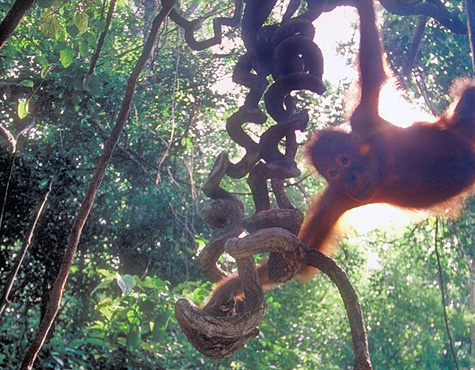
.
Tags: Borneo, Borneo Orang-utan Survival, Chelsea sugar, CSR sugar, Four Paws International, Indonesian farmers, Indonesian palm oil plantations, Kalimantan, Malaysian palm oil plantations, orang-utan, orang-utan bounty hunters, palm oil plantations, PT Restorasi Habitat Orangutan Indonesia, Sucrogen, wildlife photographers, Wilmer International
Posted in Kalimantan (ID), Orang-utans, Threats from Farming, Threats from Poaching and Poisoning | No Comments »
Add this post to Del.icio.us - Digg
Saturday, January 28th, 2012
Since 12thMay 2005, Blue Mountains Swamps have been listed as an endangered ecological community under the Environmental Protection Biodiversity Conservation Act 1999, (EPBC Act), as amended in 2005. Blue Mountains Swamps are listed under the scientific category of Temperate Highland Peat Swamps on Sandstone.
The objectives of the EPBC Act include providing for the protection of the environment, especially matters of national environmental significance and to conserve Australian biodiversity. In the case of Blue Mountains Swamps, the EPBC Act serves to prevent the actions of land use developers and others posing a significant impact upon the integrity of these vital swamp ecosystems.
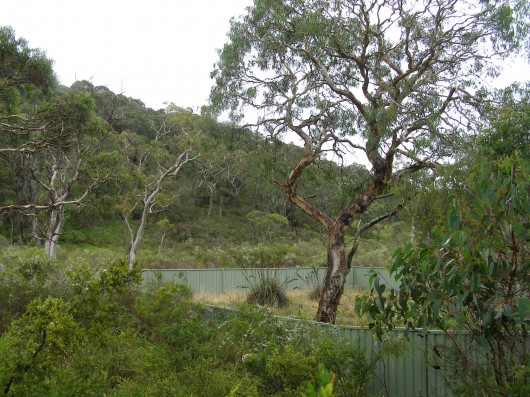 A Blue Mountains Swamp
…blatantly slashed, reclaimed and exotic grass introduced by this property development
on the wild edge of Katoomba, adjacent to the Greater Blue Mountains World Heritage Area. A Blue Mountains Swamp
…blatantly slashed, reclaimed and exotic grass introduced by this property development
on the wild edge of Katoomba, adjacent to the Greater Blue Mountains World Heritage Area.
.
 The steel fence of the development is built right into the Blue Mountains Swamp
(Photo by Editor 20120118, free in public domain, click to enlarge) The steel fence of the development is built right into the Blue Mountains Swamp
(Photo by Editor 20120118, free in public domain, click to enlarge)
.
This housing development was approved by Blue Mountains Council.
At the same time, Blue Mountains Council’s Upland Swamp Rehabilitation Programme was commenced in 2006 after Blue Mountains Swamps were listed as part of the Temperate Highland Peat Swamps on Sandstone endangered ecological community, with the aim of protecting and restoring Blue Mountains Swamp across the Local Government Area (LGA).
“In August 2008 Blue Mountains Council and Lithgow Council formed a partnership to deliver the ‘Saving our Swamps’ (S.O.S) project to restore Temperate Highland Peat Swamps on Sandstone across both LGAs. With grant funding of $250,000 over 3 years from the Urban Sustainability program of the NSW Environmental Trust, the SOS project will both strengthen Blue Mountains Council’s long term Upland Swamp Rehabilitation Programme and transfer skills to build the capacity of Lithgow Council to protect the Newnes Plateau Shrub Swamp endangered ecological community of the Newnes Plateau.”
 Local community volunteers helping Blue Mountains Council
to rehabilitate Kitty Hawk Swamp at Wentworth Falls in the Blue Mountains
[Source: Blue Mountains Council’s ‘Swampwatch’ Factsheet 7) Local community volunteers helping Blue Mountains Council
to rehabilitate Kitty Hawk Swamp at Wentworth Falls in the Blue Mountains
[Source: Blue Mountains Council’s ‘Swampwatch’ Factsheet 7)
.
“The SOS initiative will build on the Blue Mountains Council’s Upland Swamp Rehabilitation Programme, by providing funds for bush regeneration, soft engineering swamp re-hydration and creek bank stabilization in degraded Blue Mountains Swamps on both public and private land. The project will also deliver a community and school education program to raise awareness of the significance of Blue Mountains Swamps and their associated threatened species and to explain how the community can assist in their protection.
The successful partnership between BMCC and LCC was expanded in 2009 to incorporate Wingecarribee Shire Council and Gosford Council. The resultant SOS stage 2 project received a $400,000 federal Caring for Country grant over 12 months to expand the model across all four LGAS under the leadership of Blue Mountains Council.”
[Source: ^ http://saveourswamps.com.au/Blue-Mountains-City-Council.php]
.
Am I missing something here?
Blue Mountains Council receiving $250,000 plus $400,000
to save Blue Mountains Swamps,
while approving development into them?
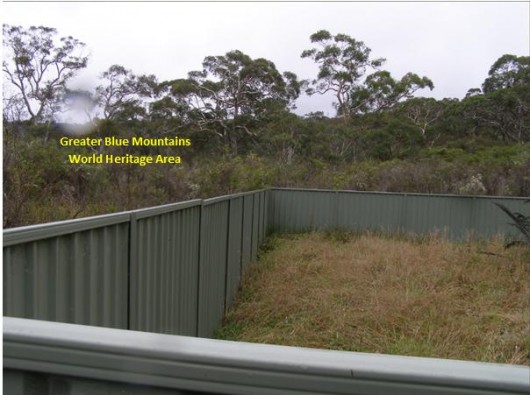 Saving Our Swamps by Council-approved slashing, bulldozing and reclamation
This is immediately adjacent to the Greater Blue Mountains World Heritage Area.
. Saving Our Swamps by Council-approved slashing, bulldozing and reclamation
This is immediately adjacent to the Greater Blue Mountains World Heritage Area.
.
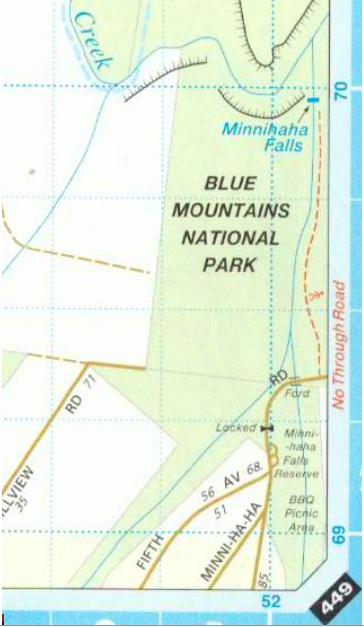 Location of Fifth Avenue adjacent to Blue Mountain National Park (BMNP)
BMNP forms part of the Greater Blue Mountains World Heritage Area. Location of Fifth Avenue adjacent to Blue Mountain National Park (BMNP)
BMNP forms part of the Greater Blue Mountains World Heritage Area.
.
“This park, which is part of the Greater Blue Mountains World Heritage Area, protects an unusually diverse range of vegetation communities. There are rare and ancient plants and isolated animal populations tucked away in its deep gorges.”
[Source: NSW Office of Environment and Heritage, NSW National Parks and Wildlife Service, ^http://www.environment.nsw.gov.au/nationalparks/parkHome.aspx?id=N0004]
.
Wednesday, January 11th, 2012
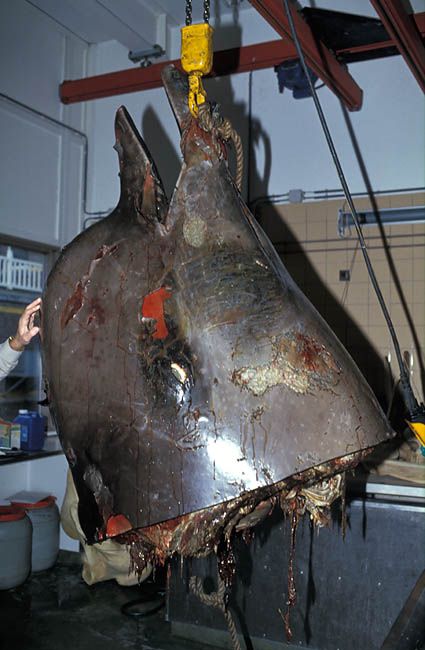 The Japanese kill bottlenose whales
(Photo: Save the Whales) The Japanese kill bottlenose whales
(Photo: Save the Whales)
.
If there is one redeeming legacy about previous British Tory Prime Minister Margaret Thatcher, despite the recurring criticism of her policies and leadership style by many Leftists, is that she was a political leader of strong convictions who commanded respect from foreign powers at a time when it was critical for Great Britain to stand by its principles.
Thatcher defended British sovereignty – its land, its people, its currency.
Not so Australia’s Labor-apparatchik installed puppet Prime Minister, Julia Gillard, who in pursuit of Rudd populism guided not by internal principle but by factions and focus groups is our chair warming PM of unprincipled mediocrity. Since her education revolution as Education Minister her costly results have been mediocre. Where are her principles? – ‘there will be no carbon tax under a government I lead‘, her extravagant $47 billion NBN without any cost-benefit study, her Malaysian solution for asylum seekers, her selling uranium to India against Labor principles and her appeasing foreign interests at Australia’s expense – US pharmaceutical and military interests, China’s mining and manufacturing interests, India’s nuclear interests and free trade with Indonesia, Malaysia and now Mexico and South American nations.
Clearly Ruddism drives Gillard foreign policy. All Gillard need do is fly in, deliver the speech and smile for the cameras, with Rudd up the back somewhere gesturing. Gillard abandoned Australia’s free speech defender Julian Assange and sided with the US Military. Japanese pirate whalers invade Australia’s Southern Ocean whale sanctuary to poach minke whales, endangered fin whales and threatened humpbacks. They now formal Japanese military support having brought their own guardian warship. Gillard doesn’t know what to do. She has a policy vacuum when it comes to the Environment, just like Labor siblings Garrett, Wong and Burke.
Rudd failed to honour his 2007 pledge to formally challenge Japanese whaling in the International Court of Justice. Only public outcry forced the Gillard Government to lodge its case with the court in May 2010. All Gillard does this time around with non-violent action group Forest Rescue boarding the Japanese whaling vessel Shonan Maru is to think legal and appeasing the pirate Japanese. Gillard has slammed the actions of three anti-whaling protesters as “unacceptable” and warned that others who carry out similar protests will be “charged and convicted”. However, the government should be preventing crimes in our near oceans, and illegal whaling, not condemning the actions of law-enforcers trying to do what they should be doing!
Gillard is gutless. Whaling is a sport. It is not scientific. It is not a primary industry because there is stuff all market for whale meat and the only way it is sold is because the Japanese Government subsidises the cost. Whaling is a cultural sport only and a backward cultural one at that. It is all about game.
The Japanese are traditionally a patriarchal society. Japanese males violating Australian waters for foreign whales for sport is consistent with Japanese male cultural history of violating foreign women they euphemistically called ‘comfort women’. Such Japanese culture is backward and foreign and has no place in Australian waters and the Australia Whale Sanctuaries that Australia is custodian for.
Japan‘s dogged pursuit of whales well beyond its shores in our Southern Ocean is more about preserving endangered cultural pride than science.
Japan‘s justifications for whaling are not commercial nor scientific, despite the official rhetoric. They are culturally deep and desperately self-preserving, despite being wrong, wasteful and backward. The scientific con is only to prevent flagrant breach of the Antarctic Treaty, to which Japan is a signatory.
Japan‘s arrogance is repeated with its refusal to respond with an apology to the request by acting Queensland Premier Lucas over Japan’s confirmed sinking of Australia’s hospital ship the Centaur in WWII. Australian’s should never forget that Japan is the only nation ever to directly threaten Australia’s sovereignty. Three generations later Japan again defies Australian sovereignty.
Gillards’ pre-election promise of getting tough on whaling (or was that Rudd’s?) was an election promise; that’s it.
.
One of the famous quotes from ‘Iron Lady’ Thatcher was “I seem to smell the stench of appeasement in the air.“
Gillard’s appeasement of Japanese whaling is the stench of her followship. Gillard is gutless. Gillard has no trait as a leader, let alone a principled leader of our nation.
Gillard has no regard for Australian sovereignty. Like her predecessor Rudd, who continues to advise on all things foreign to Australia, Gillard’s raison d’être is to comply as a puppet, enjoy her time in the sun until the next apparatchik push.
Like Rudd, Gillard treats Australian values as second rate, as if a foreigner with cultural disrespect.
Rudd reneged on his 2007 election promise to send an Australian ship to monitor Japan’s annual slaughter of 1000 minke, humpback and fin whales.
Rudd reneged on his pre-election undertaking to exercise Australia’s right to take Japan to the International Court of Justice over its whale hunting expeditions in the Southern Ocean.
Rudd’s turned his back on Japan’s harpoon whaling in Australian Antarctic waters and let Japan pirate whalers refuel in Australia.
Japan flagrantly ignores Australia’s whale sanctuary and Australia’s sovereignty. Japan condones an unprofitable, low demand and antiquainted 19th Century practice of whale harpooning, then tells international lies justifying some scientific spin that only discredits Japan’s reputation.
Japan’s Nippon Paper has been slaughtering Australian native forests for its immoral woodchip paper trade out of its habitat dead camp at its Twofold Bay mill at Eden.
How would the Japanese people like it if Gunns wanted to woodchip their sacred Aokigahara forest around the base of Mount Fuji?
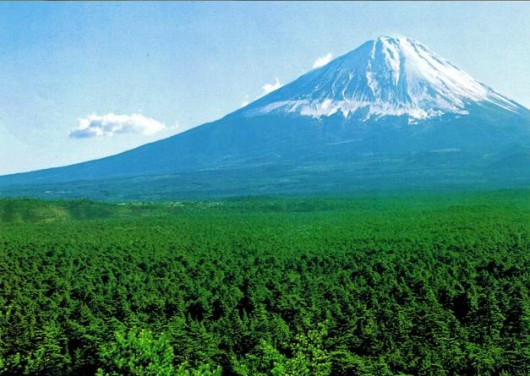 Aokigahara forest, below Mount Fuji Aokigahara forest, below Mount Fuji
.
Tags: Antarctic Treaty, Aokigahara Forest, Australia's sovereignty, Australian Government, Centaur, Gutless Gillard, International Court of Justice, Japan, Japanese whale poaching, Julia Gillard, Malaysian solution for asylum seekers, Margaret Thatcher, selling uranium to India, there will be no carbon tax under a government I lead
Posted in Antarctica (AU), Threats from Poaching and Poisoning, Threats from Weak Environmental Laws, Whales | No Comments »
Add this post to Del.icio.us - Digg
Tuesday, January 10th, 2012
[This article was first published by Tigerquoll on CanDoBetter.net on 20100416 under the same title].
 . .
Japanese contempt for whales, dolphins and sharks has highlihghted to the world the backward culture of this part of traditional Japanese society. Japanese whalers and fishing corporations have made Japan the pariah of the world’s oceans.
The Japanese lie of scientific whaling has become a cliched euphemism. Now the science has been officially confirmed as a fraud, as if we didn’t already know.
.
The following article has just been published in the online Science Daily:
.
‘DNA analysis suggests whale meat from sushi restaurants in L.A. and Seoul originated from Japan’
[Source: ScienceDaily (Apr. 14, 2010]
.
“An international team of Oregon State University scientists, documentary filmmakers and environmental advocates has uncovered an apparent illegal trade in whalemeat, linking whales killed in Japan’s controversial scientific whaling program to sushi restaurants in Seoul, South Korea, and Los Angeles, Calif.
Genetic analysis of sashimi served at a prominent Los Angeles sushi restaurant in October of 2009 has confirmed that the strips of raw meat purchased by filmmakers of the Oscar-winning documentary, “The Cove,” came from a sei whale — most likely from Japanese “scientific whaling.”
Do you want dolphin with that? ‘Scientists have identified four species of whales and one species of dolphin from a plate of sashimi, like this one sold in a restaurant in Seoul. (Credit: Photo courtesy of Louie Psihoyos, Oceanic Preservation Society)’
“The sequences were identical to sei whale products that had previously been purchased in Japan in 2007 and 2008, which means they not only came from the same area of the ocean — but possibly from the same distinct population,” said Scott Baker, associate director of the Marine Mammal Institute at Oregon State University, who conducted the analysis.
“And since the international moratorium on commercial hunting (1986), there has been no other known source of sei whales available commercially other than in Japan,” Baker added. “This underscores the very real problem of the illegal international trade of whalemeat products.”

Results of the study were published in the Royal Society journal Biology Letters. “The Cove” director Louie Psihoyos and assistant director Charles Hambleton gained the attention of international news media recently by covertly filming the serving of whale products at The Hump restaurant.
Following initial identification of the samples taken from the restaurant, the products were turned over to the National Oceanic and Atmospheric Administration’s law enforcement division and in March, federal prosecutors filed a criminal complaint against the restaurant, which since has closed. Baker said the samples taken from The Hump cannot conclusively be linked to an individual whale because genetic identity records of animals killed through Japan’s scientific whaling are not released by the Japanese government. In their paper in Biology Letters, Baker and 10 co-authors — including “The Cove” filmmakers — call for Japan to share its DNA register of whales taken from that country’s scientific whaling program and “bycatch” whaling.
“Our ability to use genetics as a tool to monitor whale populations around the world has advanced significantly over the past few years,” Baker said, “but unless we have access to all of the data — including those whales killed under Japan’s scientific whaling — we cannot provide resource managers with the best possible science.
“This is not just about better control of whaling itself,” Baker added, “but getting a better handle on the international trade of whale products.”
In their paper published in Biology Letters, lead author Baker and colleagues from the Korean Federation of Environmental Movements also report on 13 whale products purchased at a sushi restaurant in Seoul, South Korea, during two 2009 visits. The sushi was part of a mixed plate of “whale sashimi,” and genetic testing by Baker and OSU’s Debbie Steel determined that four of the products were from an Antarctic minke whale, four were from a sei whale, three were from a North Pacific minke whale, one was from a fin whale, and one was from a Risso’s dolphin.
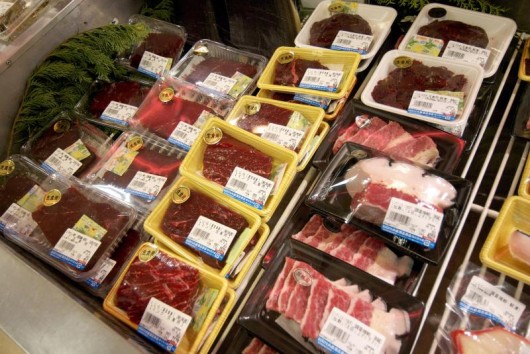
Further testing by collaborators from Seoul National University confirmed the individual identity of the whale products by DNA “profiling.” The DNA profile of the fin whale meat from the Seoul restaurant genetically matched products purchased by Baker’s colleague, Naoko Funahashi, in Japanese markets in 2007 — strongly suggesting it came from the same whale.
“Since the international moratorium, it has been assumed that there is no international trade in whale products,” Baker said. “But when products from the same whale are sold in Japan in 2007 and in Korea in 2009, it suggests that international trade, though illegal, is still an issue. Likewise, the Antarctic minke whale is not found in Korean waters, but it is hunted by Japan’s controversial scientific whaling program in the Antarctic.
“How did it show up in a restaurant in Seoul?”
Baker has developed an international reputation for his research in determining the origin of whalemeat products sold in markets around the world. His research on identification of dolphin meat contaminated with high levels of mercury was featured in “The Cove,” where he worked with Psihoyos and Hambleton. In their paper, the authors describe the long legacy of falsifying whale catch records, beginning with the Soviet Union, which failed to account for more than 100,000 whales it killed in the 20th century. This illegal, unreported or unregulated whaling “continues today under the cover of incidental fisheries bycatch and scientific whaling.”
.
Japanese love slaughtering dolphins too!
.
Each year at a cove near Taiji on the south east cost of central Japan, thousands of bottlenose dolphins and pilot whales are slaughtered by the Japanese. The cull is endorsed by the Japanese goivernment to commence on 1st September every year.
Bottlenose Dolphin, confimed as one of the most intelligent animals on the planet Typically, over six months the town’s fishermen will catch over 2,000 of Japan’s annual quota of 20,000
dolphins. Dolphin slaughter turns sea red as Japan hunting season returns “In a typical hunt the fishermen pursue pods of dolphins across open seas, banging metal poles together beneath the water to confuse their hypersensitive sonar. The exhausted animals are driven into a large cove sealed off by nets to stop them escaping and dragged backwards into secluded inlets the following morning to be butchered with knives and spears. They are then loaded on to boats and taken to the quayside to be cut up in a warehouse, the fishermen’s work hidden from the outside by heavy shutters.
‘Tensions have been rising and the culls conducted in near-secrecy since 2003, when two members of the marine conservation group Sea Shepherd released several dolphins that were being kept in an enclosure ready to be slaughtered.
During our visit we were followed at almost every turn, ordered not to take photographs and questioned by the police, who seem to view every foreign visitor as a potential hunt saboteur. None of the residents who agreed to talk would reveal their names, and requests for comments from the town office were ignored. Criticism of the dolphin hunts intensified this summer with the release of the award-winning US documentary The Cove, whose makers used remote-controlled helicopters and hidden underwater cameras to record the hunters at work. The film was released in the UK last October.
The film, with its graphic footage of the dolphin slaughter, sparked outrage after its release in the US and Australia. Last month councillors in the Australian coastal town of Broome suspended its 28-year sister-city relationship with Taiji after receiving thousands of emails protesting at the culls.
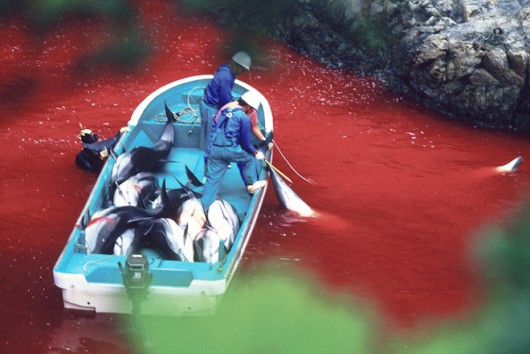 Japanese annual dolphin slaughter at The Cove, Taiji, Japan Japanese annual dolphin slaughter at The Cove, Taiji, Japan
.
Taiji is regarded as the spiritual home of Japan’s whaling industry. The first hunts took place in the early 1600s, according to the town’s whaling museum, but the industry went into decline after the introduction of a global ban on commercial whaling in 1986. The town, a six-hour train ride from Tokyo, is dotted with restaurants serving whale and dolphin sashimi and cetacean iconography appears on everything from the pavements and bridge balustrades to road tunnels and a wind turbine.”
[Source: ‘Dolphin slaughter turns sea red as Japan hunting season returns’, by Justin McCurry, The Guardian, 14-Sep-09, ^http://www.guardian.co.uk/world/2009/sep/14/dolphin-slaughter-hunting-japan-taiji].
..
Call to boycott Japanese restaurants
.
This slaughter of whales, dolphins and endangered fish such as Bluefin and sharks confirms the barbaric backwardness of traditional cultures in east Asia. Japan clearly is making a point to highlight its backwardness.
Around the world, including in Australia, Japanese restaurants continue to serve up Bluefin Tuna and Shark Fin soup and probably ‘scientific’ whale meat and dolphin. It is a disgrace!
Bluefin is critically endangered and both the scalloped hammerhead shark and whitetip shark “have seen their numbers drop dramatically since the 1980s, due to rising demand for shark fin soup especially among China’s nouveau rich and for fish and chips in Europe. Surging demand for shark fin soup among Asia’s booming middle classes is driving many species of these big fish to the brink of extinction.”
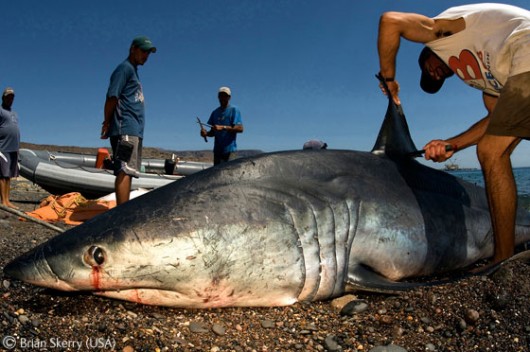
[Source: ‘Sharks threatened by Asian consumers, says Group’ Michael Casey, AP, 16 March 2010, ^http://www.physorg.com/news187936927.html]
.
In this March 8, 2010 photo, a woman walks past shark fins displayed in a glass case at a dried seafood shop in Hong Kong.
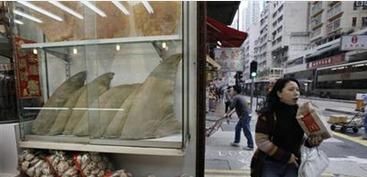 Shark Fins for sale in Hoing Kong
^http://www.physorg.com/news187936927.html Shark Fins for sale in Hoing Kong
^http://www.physorg.com/news187936927.html
.
The following example Japanese restaurants in Australia sell Bluefin and shark fin. It is time Australians boycotted such trades perpetuating wildlife extinctions.
* SYDNEY: Blue Fin Seafood Restaurant, Brighton-Le-Sands Amateur Fishermans Club, Bestic St, Brighton-Le-Sands NSW 2216
* MELBOURNE: Blue Fin, 342 Brunswick St, Fitzroy VIC 3065
* BRISBANE: Oishii Sushi Bar Shop2/70 Pinelands Rd Sunnybank Hills, Brisbane
Don’t buy Japanese – it only perpetuate’s Japan’s arrogance
.
Back in 2000, Australia and New Zealand sought an international ruling at the International Court of Justice under United Nations Convention on the Law of the Sea (UNCLOS) against Japan’s fishing of Southern Bluefin Tuna in the Southern Ocean.
Ridiculously, the court found that it had no jurisdiction to make binding rulings on Japan’s access to high seas fisheries, and that Japan can make “its own unilateral decisions as to what to fish, and where.”
So Japan continued to unilaterally embarke on a three year “Experimental Fishing Program” (EFP), that…is we want the tuna and no-one is getting in our way!
Last month at CITES COP15 meeting, Monaco had called for a global ban on bluefin tuna fishing by CITES, arguing despite stocks having fallen by about 85%, the organisation responsible for managing the bluefin fishery – the International Commission for the Conservation of Atlantic Tunas (ICCAT) – had not implemented measures strict enough to ensure the species’ survival. Australia voted against the ban, supporting Japan. ICCAT is due to meet on the bluefin issue on 14 June 2010 in Madrid Spain.
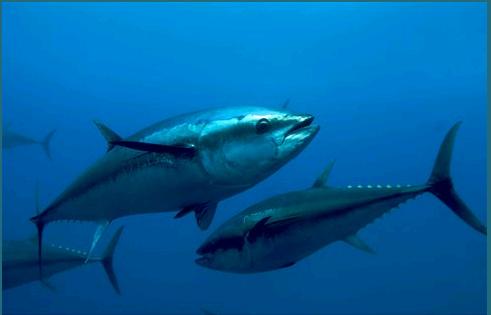
Meanwhile, in the Southern Ocean, the Commission for the Conservation of Southern Bluefin Tuna is a voluntary fishery management group comprised of Australia, Japan, New Zealand, South Korea and the Philippines as a formal cooperating non-member. Much of the Southern Bluefin Tuna catch ends up in Japan where it is prized as sushi and sushimi.
Australia’s tuna fishing industry is based in Port Lincoln in South Australia. Japanese, Korean, Indonesian and Taiwanese Bluefin tuna fleets use long line fishing which results in the incidental deaths of thousands of seabirds, particularly petrels and albatross.
For over 20 years Japan has plundered the Southern Bluefin Tuna Fishery under its unilaterally imposed ‘Experimental Fishing Program (EFP)’, similar in deception as ‘Japanese scientific whaling’. According to Humane Society International, the Scientific Committee to the Commission has estimated the SBT population is at a mere 3-8% of its pre-exploitation biomass.
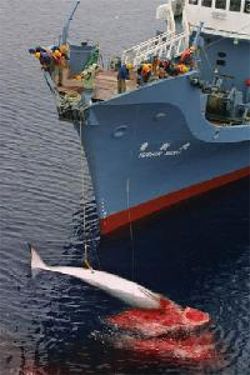
.
It is time to boycott Japanese sushi, sushimi, seafood restaurants and indeed all Japanese products, until Japan’s arrogant poaching of protected and endangered marine life is stopped!
.
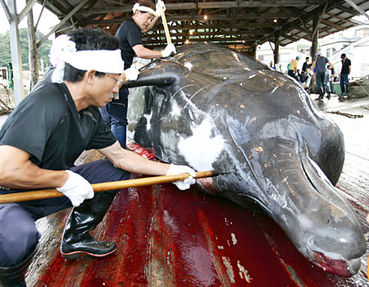 Japanese carving up Minke Whale Japanese carving up Minke Whale
.
.
Tags: backward cultures, Blue Fin Restaurant, bluefin tuna, damn lies, dolphins, Japanese whale research, sashimi, scientific whaling, shark conservation, shark fin, Taiji, The Cove, whales
Posted in Dolphins, Marine Wildlife, Threats from Poaching and Poisoning, Whales | No Comments »
Add this post to Del.icio.us - Digg
|
|
 Shree Minerals – foreign miners pillaging Tasmania’s precious Tarkine wilderness
(Photo courtesy of Tarkine National Coalition, click photo to enlarge)
Shree Minerals – foreign miners pillaging Tasmania’s precious Tarkine wilderness
(Photo courtesy of Tarkine National Coalition, click photo to enlarge)
 Spotted-tailed Quoll
Spotted-tailed Quoll
 Australia’s Minister for Environment
Tony Burke
Australia’s Minister for Environment
Tony Burke
 Utter devastation
A magnetite mine at nearby Savage River
Utter devastation
A magnetite mine at nearby Savage River

 Proposed Mine Site Plan (Direct Shipping Ore) with flows to enter tributaries of Nelson River
(Source: Shree Minerals EIS, 2011)
Proposed Mine Site Plan (Direct Shipping Ore) with flows to enter tributaries of Nelson River
(Source: Shree Minerals EIS, 2011)


































































